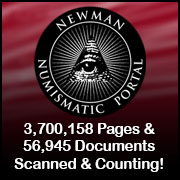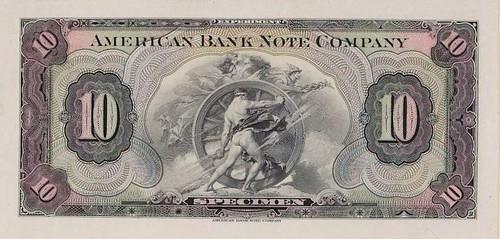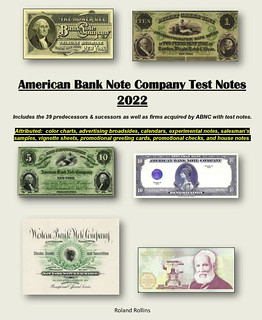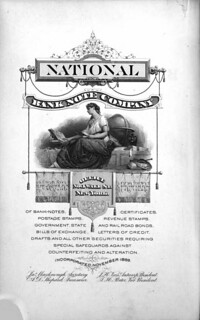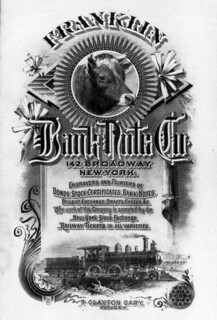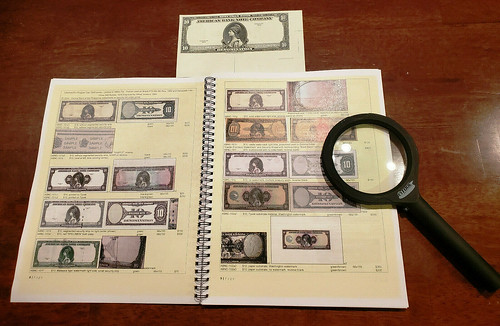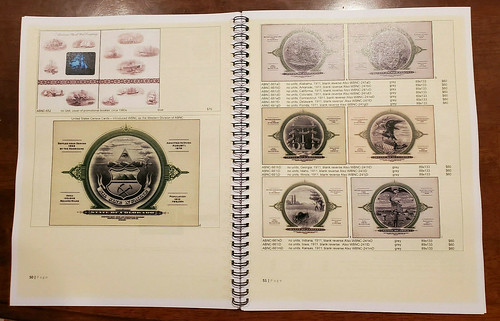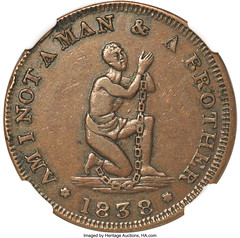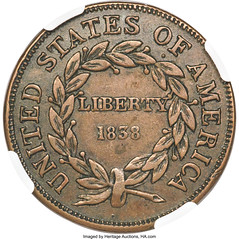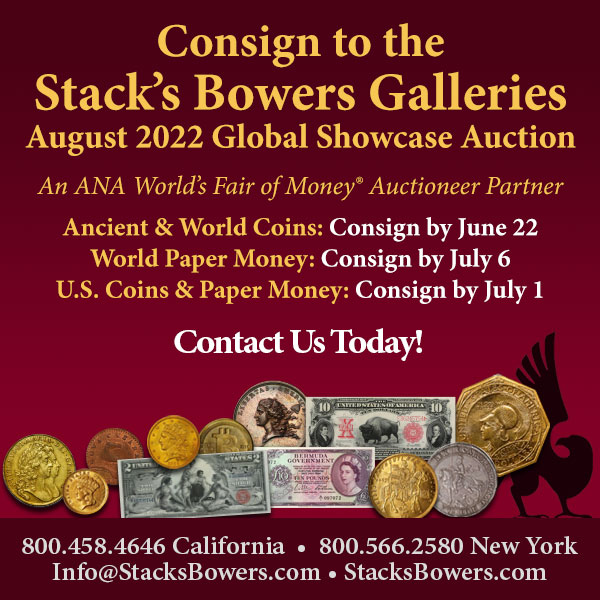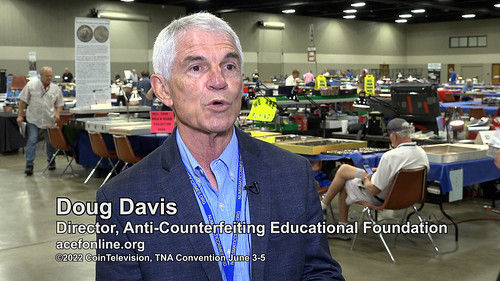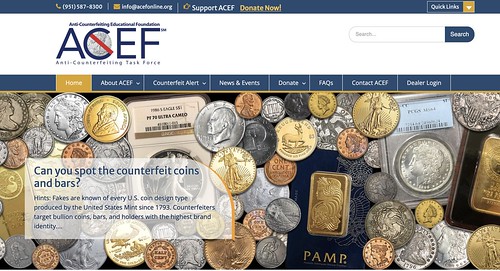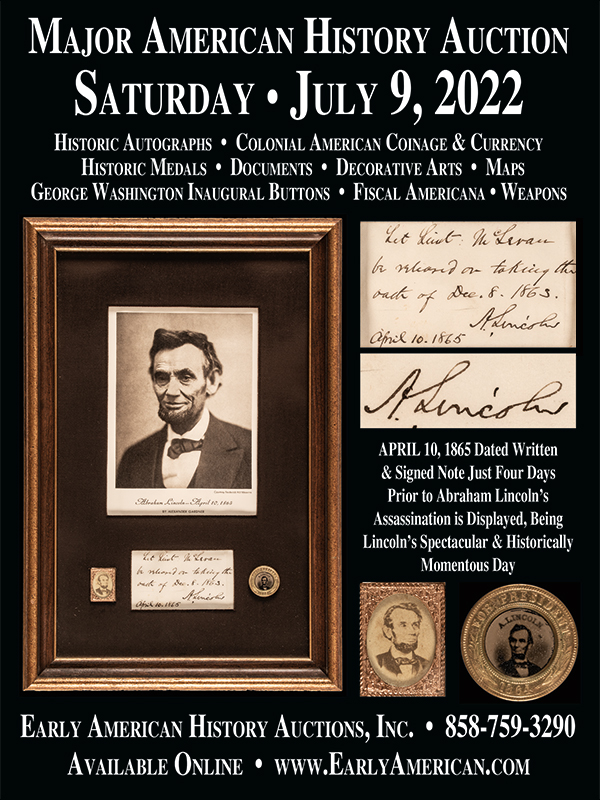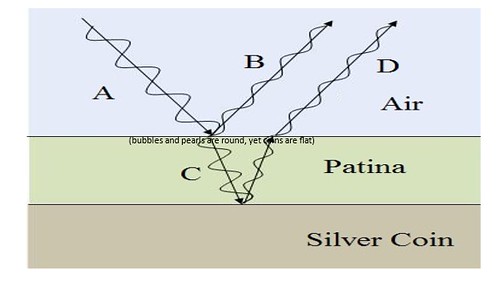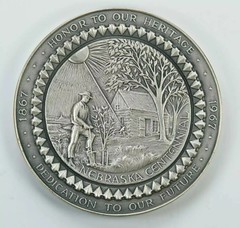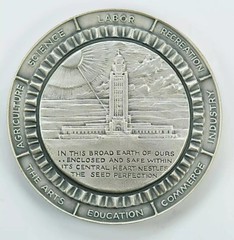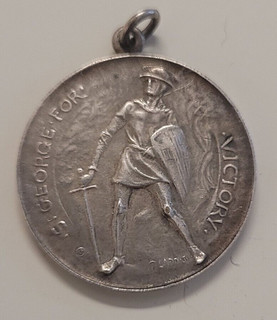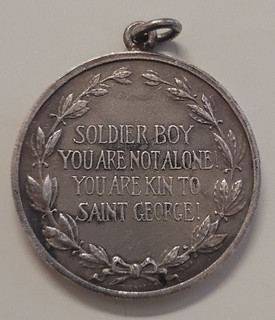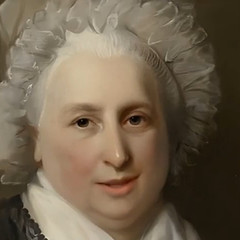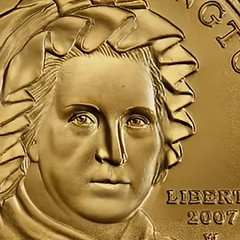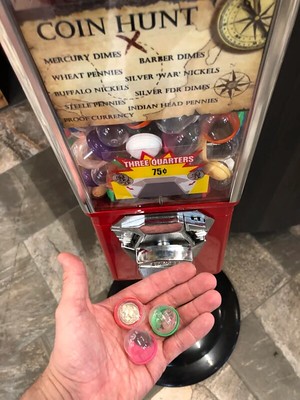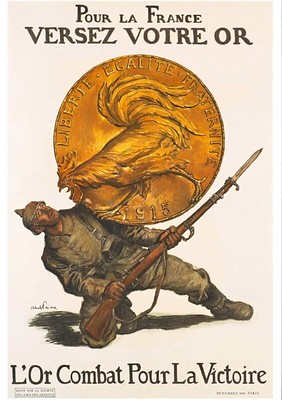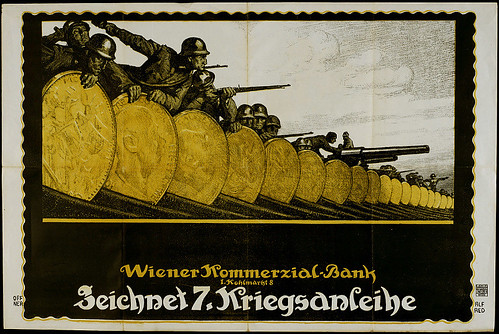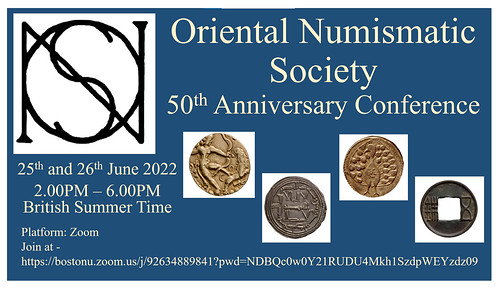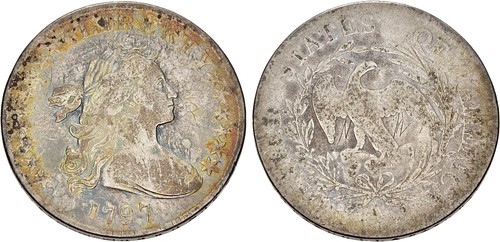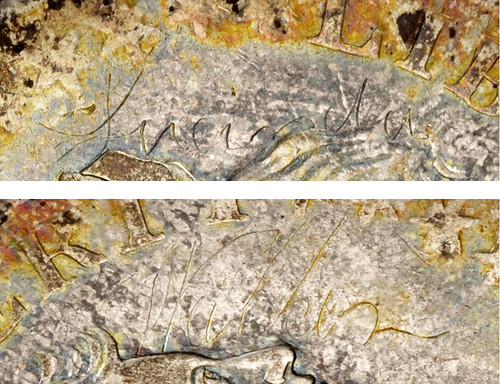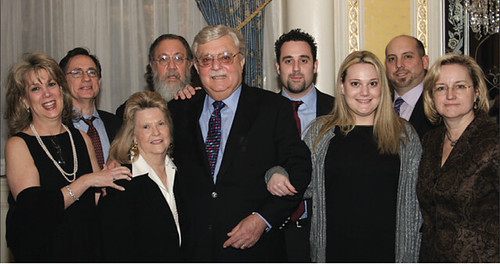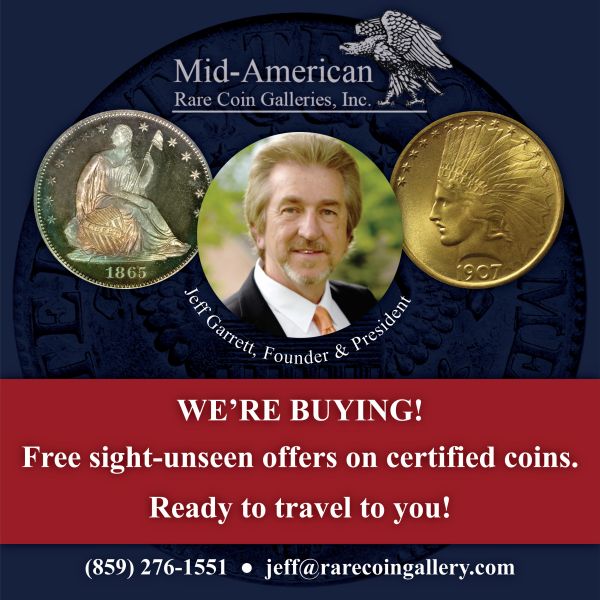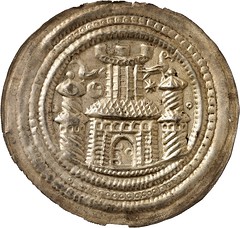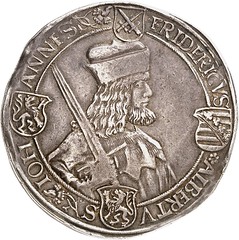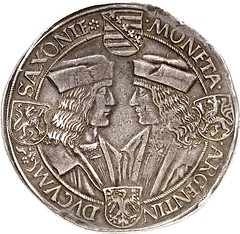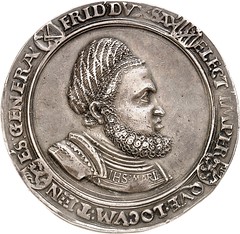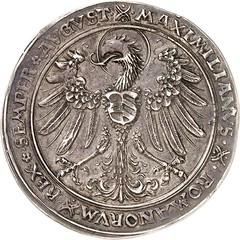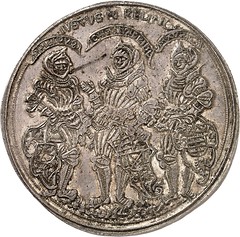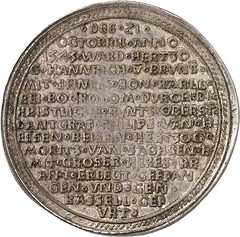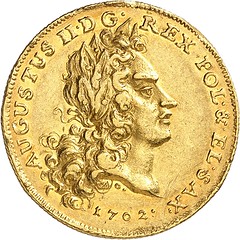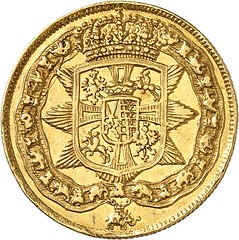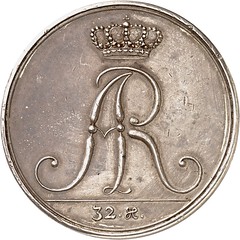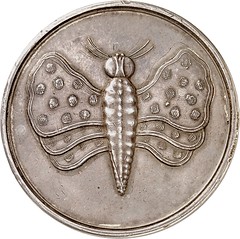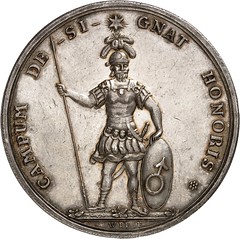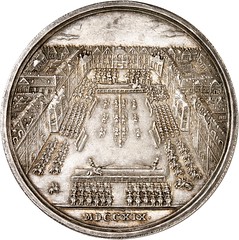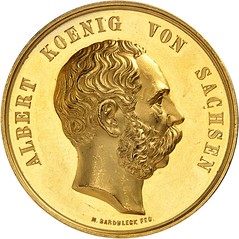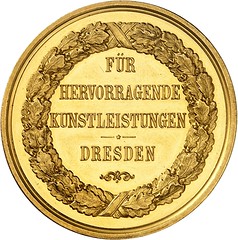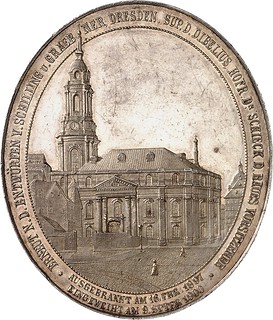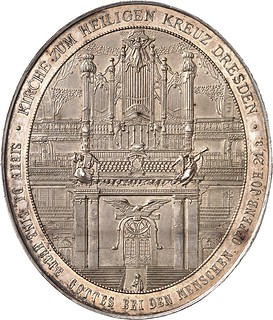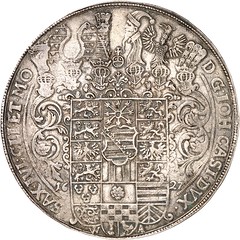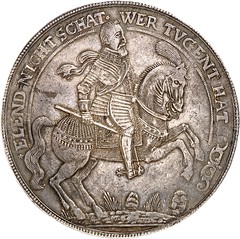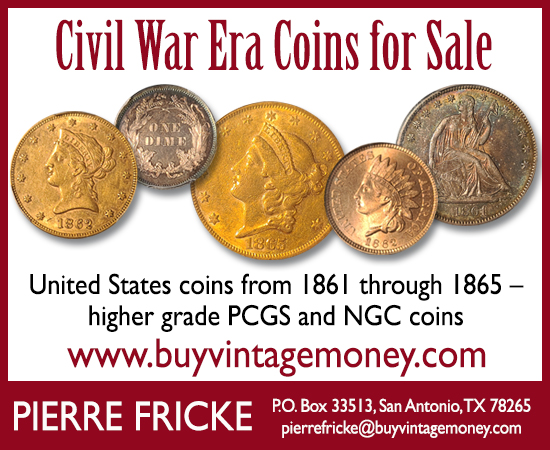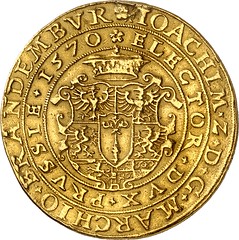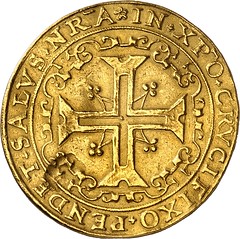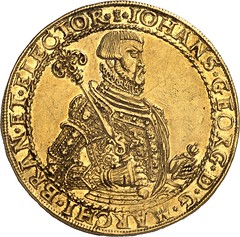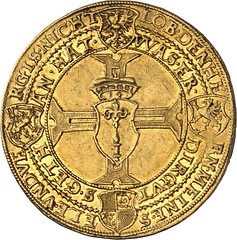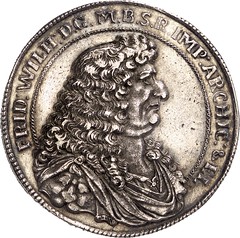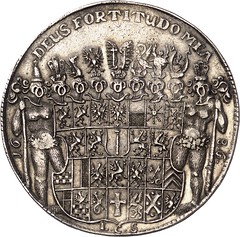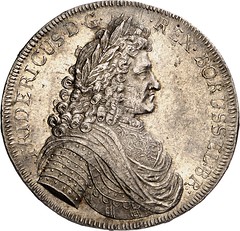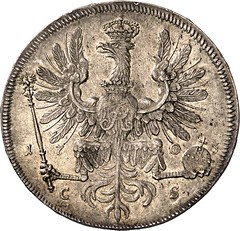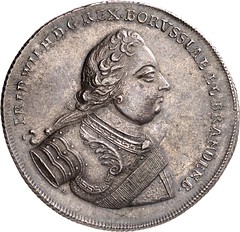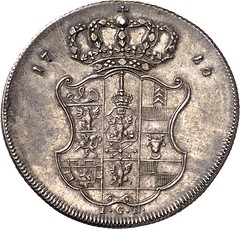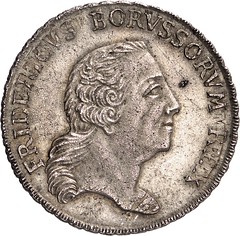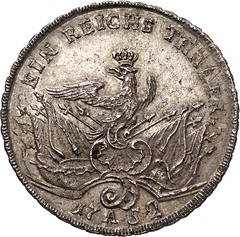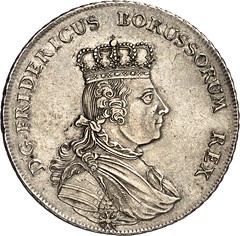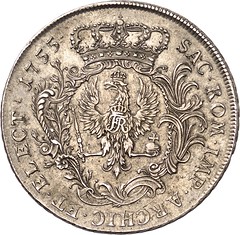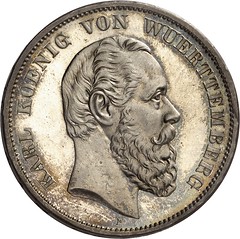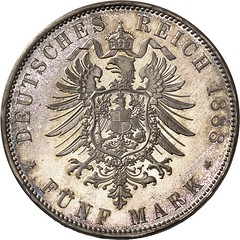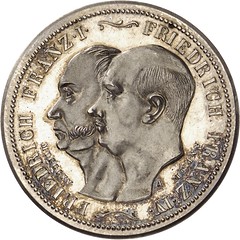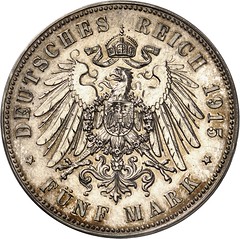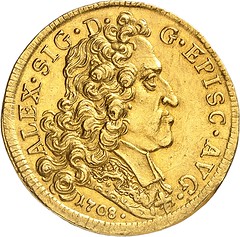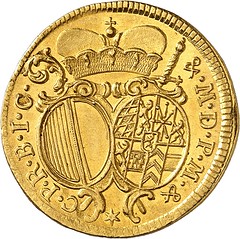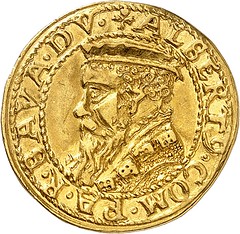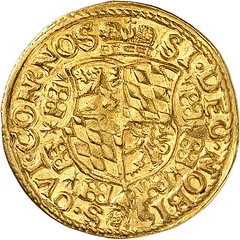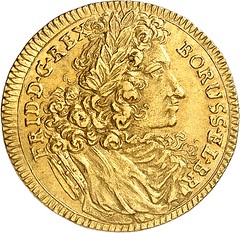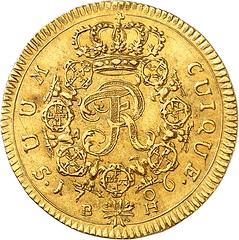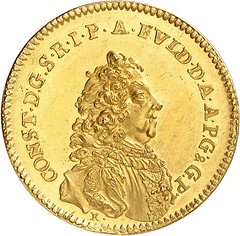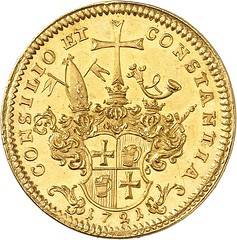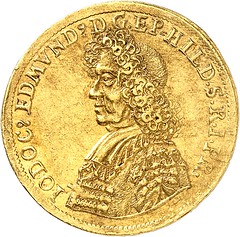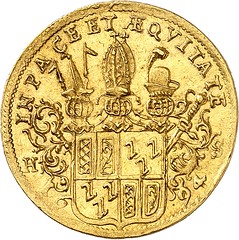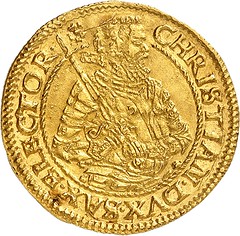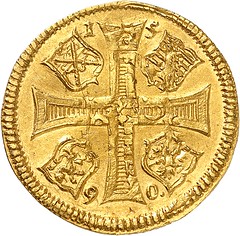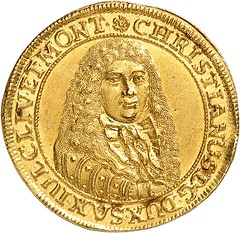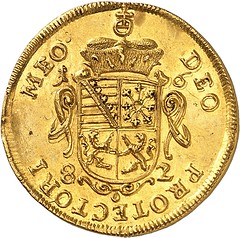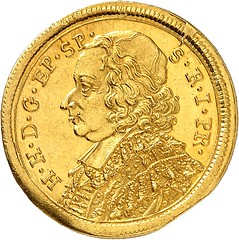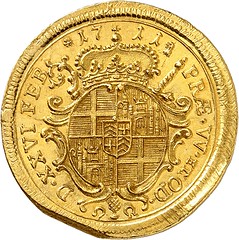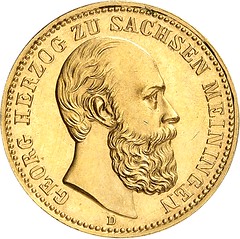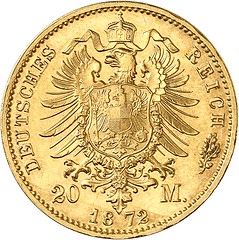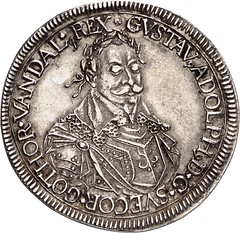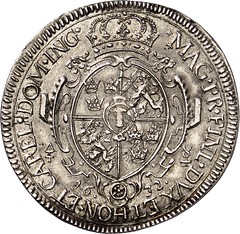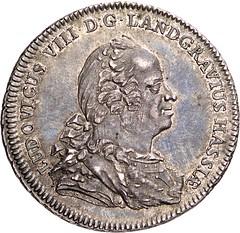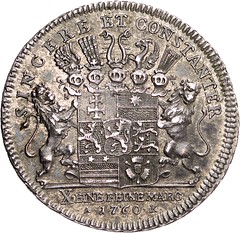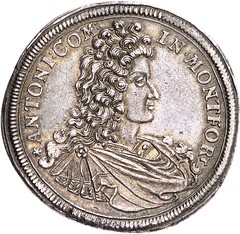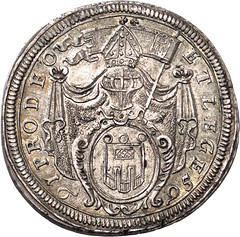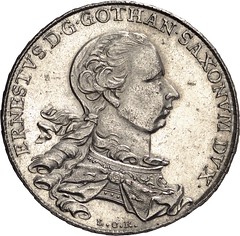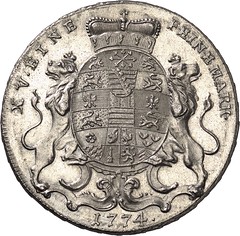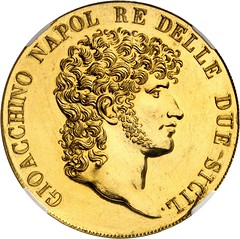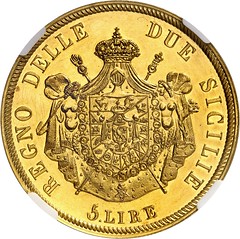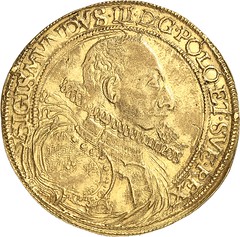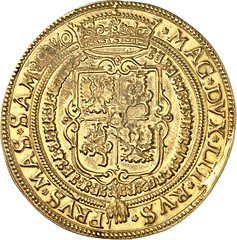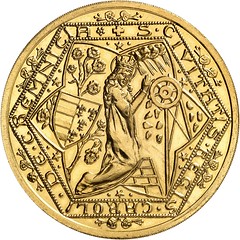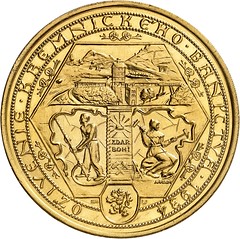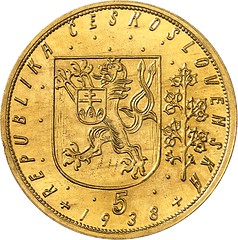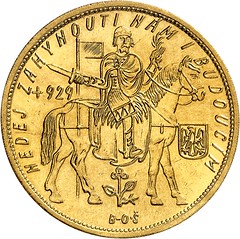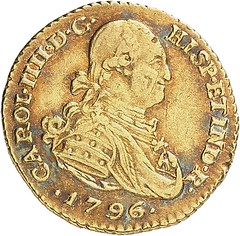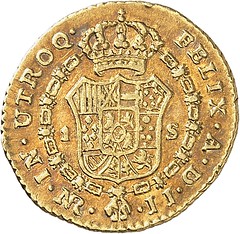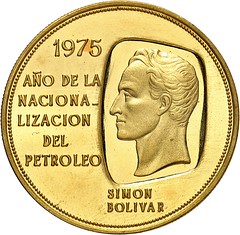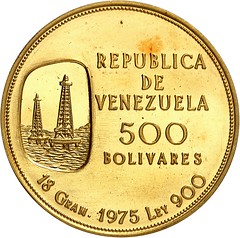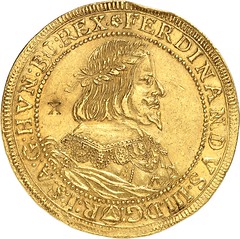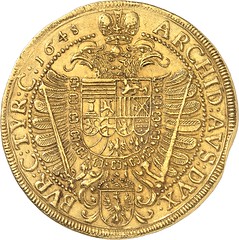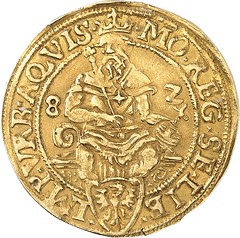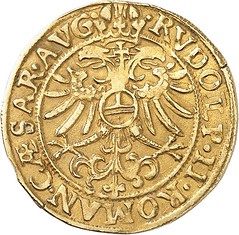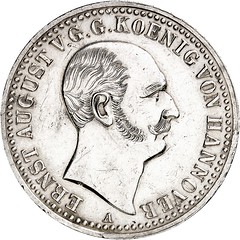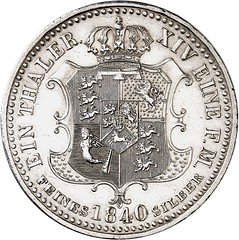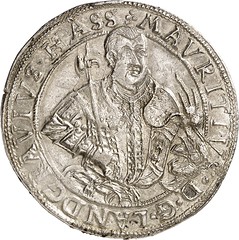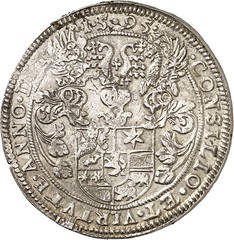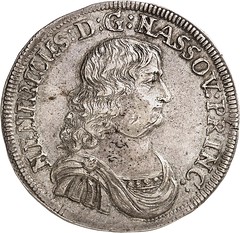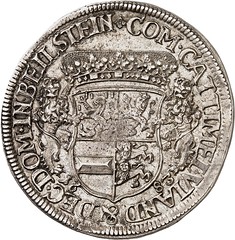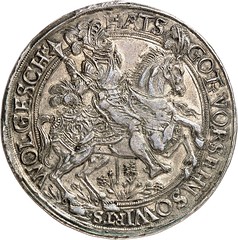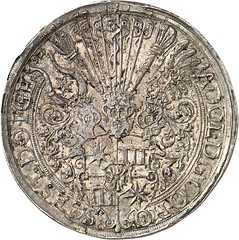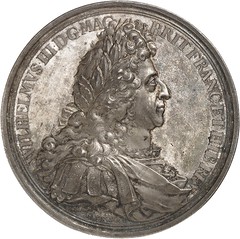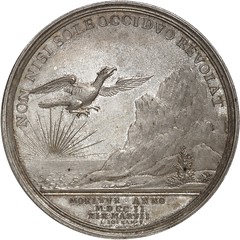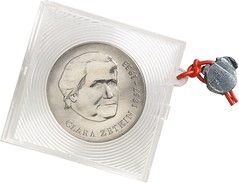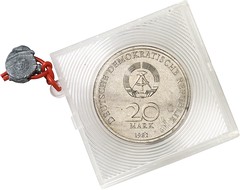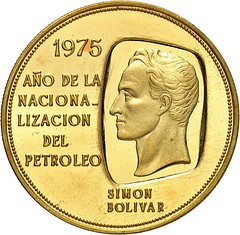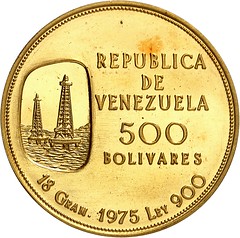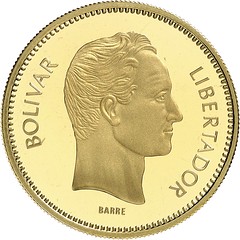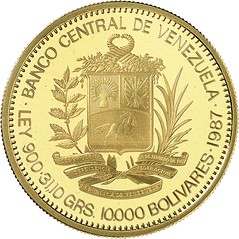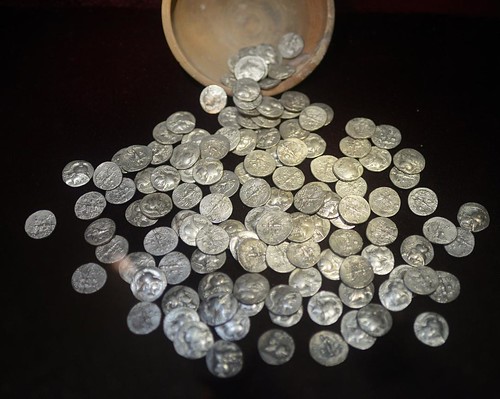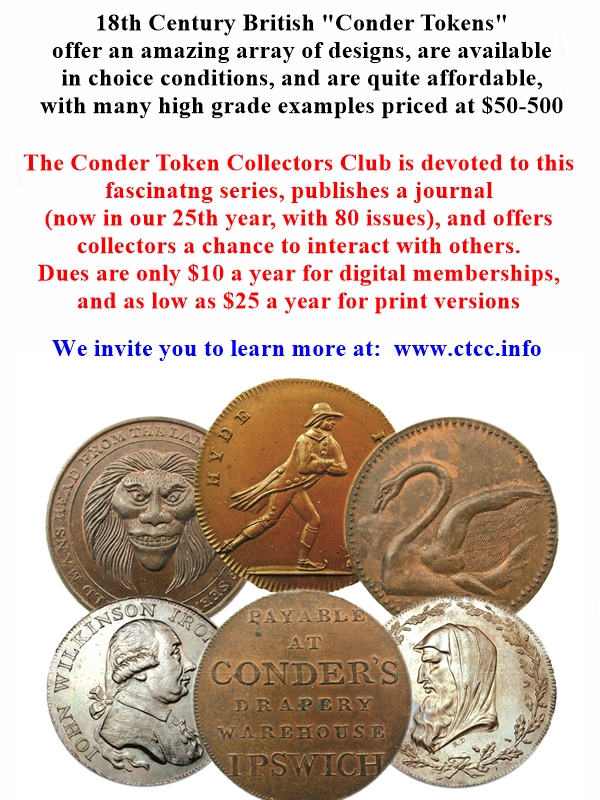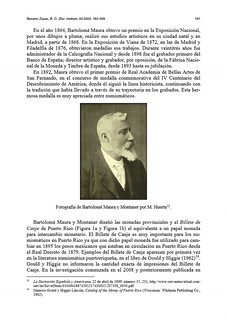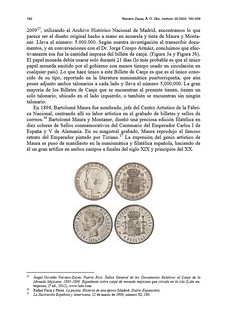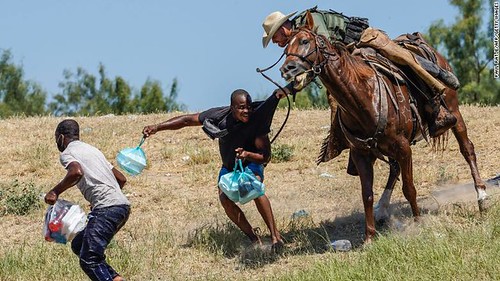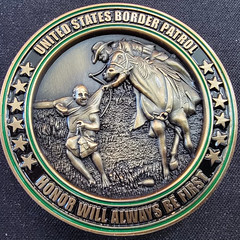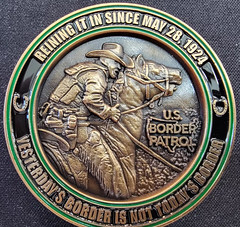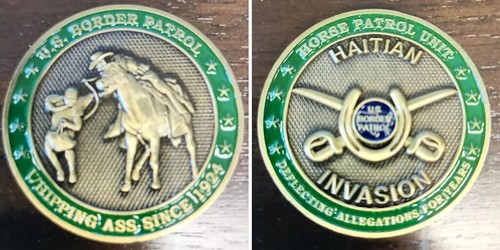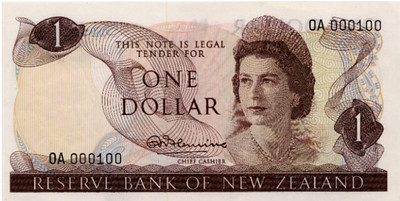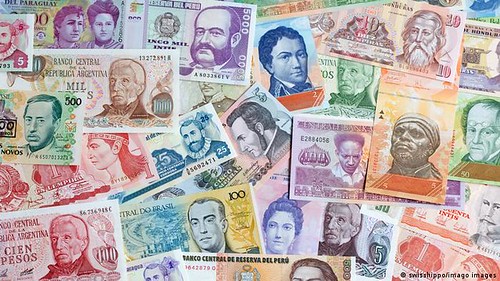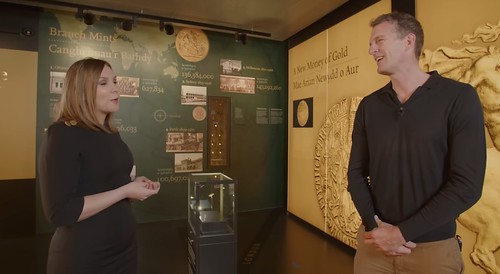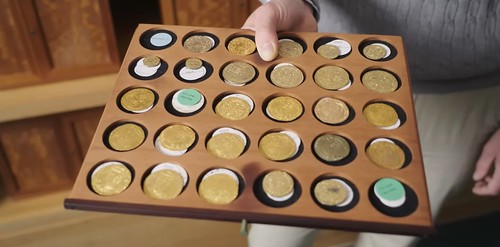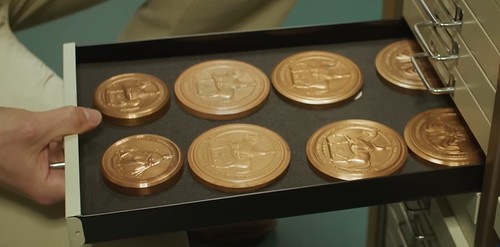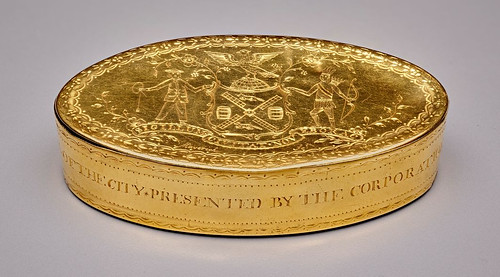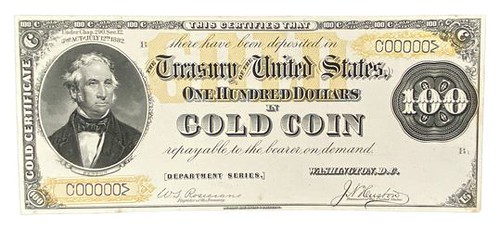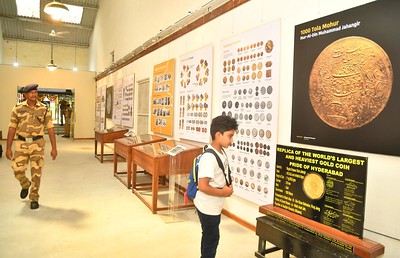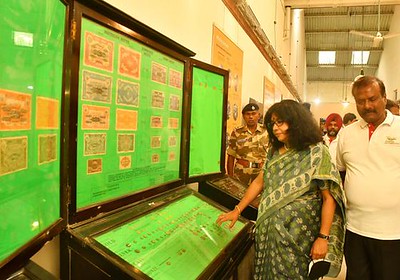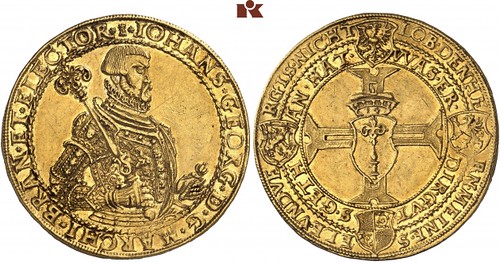
Visit our NBS Sponsors



About UsThe Numismatic Bibliomania Society is a non-profit association devoted to the study and enjoyment of numismatic literature. For more information please see our web site at coinbooks.org SubscriptionsThose wishing to become new E-Sylum subscribers (or wishing to Unsubscribe) can go to the following web page link MembershipThere is a membership application available on the web site Membership Application To join, print the application and return it with your check to the address printed on the application. Print/Digital membership is $40 to addresses in the U.S., and $60 elsewhere. A digital-only membership is available for $25. For those without web access, write to: Charles Heck, Treasurer AsylumFor Asylum mailing address changes and other membership questions, contact Chuck at this email address: treasurer@coinbooks.org SubmissionsTo submit items for publication in The E-Sylum, write to the Editor at this address: whomren@gmail.com BUY THE BOOK BEFORE THE COINSale CalendarWatch here for updates! |
- WAYNE'S WORDS: THE E-SYLUM JUNE 19, 2022
- NEW BOOK: AMERICAN BANK NOTE TEST NOTES 2022
- NEW BOOK: ITALIAN PAPER MONEY, 12TH ED.
- NEW BOOK: ITALIAN 'MINI-CHECKS'
- NEW BOOK: THE WATLINGTON HOARD
- JOURNAL OF EARLY AMERICAN NUMISMATICS JUNE 2022
- GARY SNOVER (1938-2022)
- NEWMAN ON
AM I NOT A WOMAN AND A SISTER
- JOHN FORD SPEAKS ON THE BROWNING REPRINT
- VIDEO: ANTI-COUNTERFEITING EDUCATIONAL FOUNDATION
- NOTES FROM E-SYLUM READERS: JUNE 19, 2022
- ORIENTAL NUMISMATIC SOCIETY 50TH CONFERENCE
- THE DEMISE OF WOMEN IN NUMISMATICS
- THE DEMISE OF LIVE AUCTIONS?
- VOCABULARY TERM: JEWELRY FINISH
- DONALD PAUL TAXAY (1933-????)
- THE LUCINDA WALKER SILVER DOLLAR
- THOMAS URAM RECIEVES ANA KRAUSE AWARD
- ANA PHILANTHROPY AWARDS: BOWERS, STACKS FAMILY
- LONG BEACH EXPO, JUNE 30-JULY 2, 2022
- KEUNKER 2022 SUMMER AUCTION SALE 368
- KEUNKER 2022 SUMMER AUCTION SALE 369
- KEUNKER 2022 SUMMER AUCTION SALE 370
- KEUNKER 2022 SUMMER AUCTION SALE 371
- KEUNKER 2022 SUMMER SALES: VENEZUELAN COINAGE
- ROMAN SILVER COIN HOARD FOUND IN ROMANIA
- MEXICAN CURRENCY EXCHANGE IN PUERTO RICO
- BORDER PATROL "WHIPPING' CHALLENGE COINS
- ELIZABETH II ON NEW ZEALAND CURRENCY
- A SINGLE LATIN AMERICAN CURRENCY?
- HIDDEN TREASURES OF THE ROYAL MINT MUSEUM
- YALE'S GOLD IN AMERICA EXHIBIT
- THE SAIFABAD MINT MUSEUM
- LOOSE CHANGE: JUNE 19, 2022
Click here to read the thin version on the web
Click here to subscribe
Click here to access the complete archive
To comment or submit articles, reply to whomren@gmail.com
Content presented in The E-Sylum is not necessarily researched or independently fact-checked, and views expressed do not necessarily represent those of the Numismatic Bibliomania Society.
WAYNE'S WORDS: THE E-SYLUM JUNE 19, 2022
 New subscribers this week include:
Jeffrey Rill, courtesy of CNG; and
new NBS member Michael Fahey.
Welcome aboard!
New subscribers this week include:
Jeffrey Rill, courtesy of CNG; and
new NBS member Michael Fahey.
Welcome aboard!
Thank you for reading The E-Sylum. If you enjoy it, please send me the email addresses of friends you think may enjoy it as well and I'll send them a subscription. Contact me at whomren@gmail.com anytime regarding your subscription, or questions, comments or suggestions about our content.
This week we open with four new books, a new JEAN issue, updates from the Newman Numismatic Portal, notes from readers, and more.
Other topics this week include ABNCo test notes, Italian paper money, the Browning book on early U.S. quarters, Women in Numismatics, Don Taxay, Lucina Walker, Tom Uram, the Oriental Numismatic Society conference, auction previews, and Border Patrol challenge coins.
To learn more about the Watlington Hoard, Benjamin Dudley, Thomas Goadsby, Gary Snover, ghost images
on old copper coins, toning, the 1875 William Douglas auction sale, the demise of live auctions, jewelry finish, the Long Beach Expo, the summer Keunker sales, and the Royal Mint Museum collection, read on. Have a great week, everyone!
Wayne Homren
Editor, The E-Sylum
NEW BOOK: AMERICAN BANK NOTE TEST NOTES 2022
Roland Rollins has published an update to his book on American Bank Note Company promotional sheets and test notes. He passed along this announcement. -Editor
I released the new 2022 edition of the American Bank Note Test Catalog in March. The first edition in 2019 sold out in 3 months.
1. Spiral bound book to lay flat while open, no breaking the binding.
2. UV (ultraviolet), close up, and sharp angle images to show security features present.
3. Current valuations in uncirculated or best known condition for all notes.
4. 109 pages - 84 in 2019!
5. All COLOR NOTE IMAGES, attributing all sub-varieties, such as date, logo, address, color, material, security device differences, and others.
6. All 39 known ABNC predecessor firms producing test notes, including Printer's test, house and advertising notes from the 1820's forward. There were 27 firms in the 2019 book!
7. Images of 95+% of each test note set.
8. Only test note catalog for the American Bank Note Company.
9. Table of Contents lists Firm, number of unique cataloged notes, number of sub-varieties and comments. Now also shows the alpha catalog designation for each firm. For example, ABNC has 167 test notes with 318 varieties attributed.
10. Cross reference "family trees" of all firms that formed the American Bank Note Company.
11. Cost is $25 plus $4.50 shipping for US collectors.
The catalog is available on Ebay or directly from my website using cash, check, money order, or PayPal at: http://currency_den.tripod.com/testnotes/order.html
To read the earlier E-Sylum article, see:
NEW BOOK: PROMOTIONAL SHEET & TEST NOTES
(https://www.coinbooks.org/v23/esylum_v23n15a07.html)
NEW BOOK: ITALIAN PAPER MONEY, 12TH ED.
Here's a Google-translated announcement of a new catalog on Italian paper money. -Editor
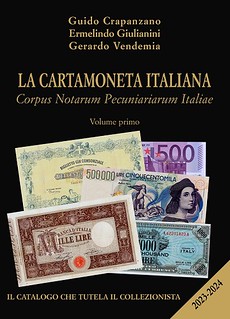 This innovative price catalog created in 2003 by Guido Crapanzano and Ermelindo Giulianini is now a
This innovative price catalog created in 2003 by Guido Crapanzano and Ermelindo Giulianini is now a classic
for all banknote collectors and has been updated with competence and attention by the professional Gerardo Vendemia for some years.
In this 2023-2024 edition, there are 368 color pages that survey the paper issues of the National Bank in the Kingdom, consortium and former consortium notes, cash vouchers and state notes. This is followed by the issues of the Kingdom and the Republic in the name of the Bank of Italy, the euro, the banknotes relating to Italian occupations abroad and foreign ones in the Italian territories, to conclude with an appendix dedicated to the first series.
The author writes in the Preamble that the delay of this edition, relating to the two-year period 2023-2023, was due to the pandemic but that this allowed both to make the contents more usable and to be able to receive consolidated prices for many types of tickets.
To the standard types - those collected by most fans - are added unpublished, unapproved tickets, partial projects for banknotes that never saw the light and of which the volume contains news and illustrations.
One of the innovative features of the Italian paper money catalog is the presence of QR codes which, when framed with the smartphone camera, allow access to the CartamonetaItaliana.com virtual museum cards .
The Italian paper money catalog (Isbn 979-12-210-0675-9) is available at a price of 12 euros payable, as indicated on the Cartamoneta.com website , by check, bank transfer, credit card, PayPal and money order. To the catalog price must be added € 6.95 for registered shipping (estimated delivery in 3 working days) or € 8.25 for insured shipping (estimated delivery in 1 working day).
For more information, or to order, see:
NUOVO CATALOGO BANCONOTE LA CARTAMONETA ITALIANA 2023/24 VOLUME PRIMO CRAPANZANO
(https://www.cartamoneta.com/nuovo-catalogo-banconote-la-cartamoneta-italiana-2023-24-volume-primo-crapanzano.html?___store=it)
Found via News & Notes from the Society of Paper Money Collectors (Volume VII, Number 52, June 14, 2022) -Editor
To read the complete article, see:
LA CARTAMONETA ITALIANA
: disponibile la 12a edizione del CATALOGO
(https://www.cronacanumismatica.com/la-cartamoneta-italiana-disponibile-la-12a-edizione-del-catalogo/)
NEW BOOK: ITALIAN 'MINI-CHECKS'
And here's a Google-translated announcement of a new catalog about the Italian 'mini-checks' emergency money of the 1970s. -Editor
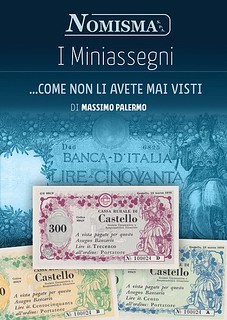 The title of the research curated by Massimo Palermo, I miniassegni ... as you have never seen them , immediately makes us understand that we are not dealing with a traditional catalog, of those we are all used to consulting, but something different and innovative, which brings mini-checks to occupy the right space they deserve within our collecting landscape and monetary history. It is no coincidence that the author omitted the word "catalog" on the cover.
The title of the research curated by Massimo Palermo, I miniassegni ... as you have never seen them , immediately makes us understand that we are not dealing with a traditional catalog, of those we are all used to consulting, but something different and innovative, which brings mini-checks to occupy the right space they deserve within our collecting landscape and monetary history. It is no coincidence that the author omitted the word "catalog" on the cover.
The introductory part of the volume concerns an exhaustive explanation of this particular monetary form , in all its aspects, with the specific intent of breaking down all the clichés that have been read on mini-checks for years (such as "it's just waste paper" or "It was just a scam of the banks") providing us, even with precise data, a new vision of things that no one had investigated in this way until now. A real turning point that rewrites the history of mini checks.
The mini-checks, moreover, in the seventies, were a very important monetary phenomenon for Italy in a period in which, due to the oil and economic crisis, the Mint produced a reduced quantity of metallic money. Thus, the Italians learned to deal with those colorful - often beautiful and refined - rectangles of paper in the name of many credit institutions that circulated as hard cash.
The part relating to the cataloging has very modern graphics and is very rich in content. Over twenty years of research by the author have in fact led to numerous discoveries that are published for the first time: one above all, the discovery of an exceptional mini-check of the Banco di Napoli headed to the Union of Commerce and Tourism of the Province of Savona , with just three known specimens.
All types of mini-checks are dealt with and explained : ordinary and first projects, figured, false, invented, unissued, specimen, offset, overprinted, long format and - in the last part of the volume - the numerical classification of the banks for the most demanding collectors.
For more information, or to order, see:
I MINIASSEGNI... COME NON LI AVETE MAI VISTI
(https://auctions.nomismaweb.com/it/sitem/14226/i-miniassegni-come-non-li-avete-mai-visti-/)
Also found via News & Notes from the Society of Paper Money Collectors (Volume VII, Number 52, June 14, 2022) -Editor
To read the complete article, see:
I MINIASSEGNI… come non li avete mai visti
(https://www.cronacanumismatica.com/i-miniassegni-come-non-li-avete-mai-visti/)
NEW BOOK: THE WATLINGTON HOARD
Lee Toone alerted me to the publication of a new book on the Watlington Hoard. Thank you! -Editor
The Watlington Hoard
Coinage, Kings and the Viking Great Army in Oxfordshire, AD875–880
By John Naylor, Eleanor Standley
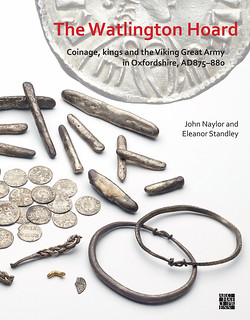 Presenting the complete publication of the objects and coins in the Watlington Hoard, the authors discuss its wider implications for our understanding of hoarding in late 9th-century southern Britain, interactions between the kingdoms of Wessex and Mercia, and the movements of the Viking Great Army after the Battle of Edington in 878.
Presenting the complete publication of the objects and coins in the Watlington Hoard, the authors discuss its wider implications for our understanding of hoarding in late 9th-century southern Britain, interactions between the kingdoms of Wessex and Mercia, and the movements of the Viking Great Army after the Battle of Edington in 878.
The Watlington Hoard was discovered in southern Oxfordshire in 2015 by a metal-detectorist, and acquired by the Ashmolean Museum, Oxford in 2017. A nationally-important find of coinage and metalwork, and the first major Viking-Age hoard from the county, it dates from the late 870s, a fundamental and tumultuous period in Britain's history. The contents of the hoard include a highly significant collection of over 200 silver pennies, mostly of Alfred the Great, king of Wessex, and Ceolwulf II, king of Mercia, transforming our understanding of the coinage in this period, and 23 silver and gold pieces of contemporary metalwork much of which was derived from Scandinavia.
Presenting the complete publication of the objects and coins in the Watlington Hoard – including an important re-assessment of the coinage of the late 870s – the authors discuss its wider implications for our understanding of hoarding in late 9th-century southern Britain, interactions between the kingdoms of Wessex and Mercia, and the movements of the Viking Great Army after the Battle of Edington in 878. The book also relates another side to the hoard's story, beginning with its discovery and excavation, charting its path through the conservation work and acquisition by the Ashmolean Museum to the public outreach projects which ran alongside the scholarly research into the hoard.
About the Authors
Dr John Naylor is the Portable Antiquities Scheme's National Finds Adviser for Early Medieval and Later Coinage, based in the Heberden Coin Room at the Ashmolean Museum, Oxford. His research focuses on the archaeology and numismatics of early medieval Europe.
Dr Eleanor Standley is Curator of Medieval Archaeology in the Department of Antiquities at the Ashmolean Museum, Oxford and Associate Professor of Later Medieval Archaeology in the School of Archaeology, University of Oxford. Her research focuses on the later medieval period in Britain and Europe, with a special interest in daily life and the socio-cultural significance of everyday objects.
Lee adds:
"Interesting and bold that they have published this simultaneously in both print and open access pdf form!"
To order or download, see:
https://www.archaeopress.com/Archaeopress/Products/9781789698299
JOURNAL OF EARLY AMERICAN NUMISMATICS JUNE 2022
The latest issue of JEAN, the Journal of Early American Numismatics has been published by the American Numismatic Society. Here is the table of contents and an excerpt from the Editor's Preface by Christopher R. McDowell. -Editor
Table of Contents
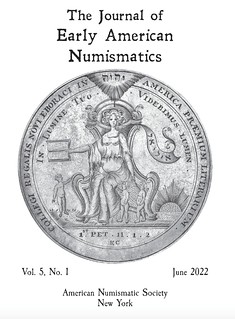
Editor's Preface
The King's College, New York, Literary Society Medals
John Sallay
Benjamin Dudley: Maker of the Nova Constellatio Patterns
Julia Casey
The Continental Dollar:
Some Observations and Suggested Research
John Sallay, Patrick McMahon
Appendix to The Continental Dollar
:
Evidence from the ANS Collection
Jesse Kraft
Determining Why Ghosts
Occur
on the Unstruck Side of Uniface Coins
Roger A. Moore, James A. Biancarosa, Daniel Carr
Coronas, Clacos, and Cacao:
The Plea for Copper Coinage in New Spain (1764–1771)
Jesse Kraft, Ángel Navarro Zayas
Thomas Goadsby: New Jersey Coiner
Gary A. Trudgen
The Early Coinage of Tortola:
Numismatic Traces of a Most Heinous Murderer?
Jeff Rock
Wow - what a great collection of writers and topics. Quality begets quality - just when you think a JEAN issue can't be beat, along comes one even better! -Editor
Editor's Preface
Welcome to the fifth year of the Journal of Early American Numismatics (JEAN), the successor publication to The Colonial Newsletter (CNL). We have grown from the five-page acorn planted in October 1960 to the leafy volume you hold today. CNL and JEAN have brought our subscribers the very best in numismatic research for the past 62 years; that strong tradition continues today. This is a fantastic issue. It is the best we have ever published. I don't know how we can ever hope to do better than this, but we shall try.
The anchor
article in this issue is a brilliant piece by John Sallay. His monograph may be one of the best-written articles we have ever published. If it does not win accolades, I will be shocked. Indeed, it is my opinion that it is a strong candidate for the numismatic article of the year along with two other articles in this issue. The editorial staff struggled to improve it. Indeed, one editor wrote me back after I sent it out for review that he had no edits—if only every article were that way. John's research is impeccable, and the subject matter is fascinating. These medals are crucial pieces of Americana. They were issued to students for academic merit before the Revolution at New York's King's College, now Columbia University. In learning about these engraved medals, you will get a great sense of pre-Revolutionary New York City. Oh, I almost forgot to mention that they were engraved by Elisha Gallaudet (E.G.), the erstwhile engraver of the Continental
dollar dies!
Julia Casey provides her research to us on the Nova Constellatio coinage. Reasonable people may disagree, but I think this is Julia's best article yet. It is everything I like in a JEAN article. There are certain past numismatic researchers whose musings and speculations are accepted today as the gospel truth without any thought or scrutiny. My favorite articles are iconoclastic, written by brave modern researchers willing to challenge conventional wisdom and strike a new path guided by original research and truth. This is such an article. Julia takes on the Nova Constellatio mystery, casting aside everything we once thought was true. We are now shown a new path that seems much brighter than that which we once stumbled blindly along. It is difficult for me to judge if the truths revealed in this article will immediately take hold; old numismatic habits die hard, but, in my opinion, Julia has it right. When all is said and done, this may be the most important and influential article in this issue.
The next article may be familiar to some. It is a reprint of a superb article on the Continental dollar by John Sallay and Patrick McMahon that recently appeared in the MCA Advisory. However, JEAN's staff have taken it and added some excellent materials—images of the edges of European coins from the ANS vault that are similar in appearance to the edge markings on the Continental dollar. I feel these images and the brief notes added by Dr. Kraft greatly enhance the piece. The edge is the third side of a coin and the side most often ignored. However, edge markings may hold key clues as to the origin of the Continental dollar. At this point, the evidence is compelling that the Continental dollar was not struck in America or issued as a circulating currency in America or for America. There will always be doubters among us—after all, there is still a Flat Earth Society, which I understand has a robust membership. While we lack the smoking gun to prove the European origin theory, the circumstantial evidence piles up. In Ye Editor's opinion, it is a matter of time before the critical piece of the puzzle is located.
Our next offering is a technical article by Dr. Roger Moore with the assistance of several co-authors. As of late, this journal has neglected technical pieces in favor of historical monographs. Dr. Moore and his colleagues help right the ship with a scientific approach to ghost images
on old copper coins. Sometimes the answer to a question requires old-fashion elbow grease, table-top experimentation, trial and error, and the scientific method. Many of our subscribers come from a scientific background and yearn for such articles. Besides articles espousing XRF analysis's virtues, Ye Editor receives few technical articles submitted for peer review and publication. This is an open invitation to all our readers with a scientific bent to please put your numismatic experiments on paper and submit them for publication.
Drs. Kraft and Zayas have prepared a spectacular article on a specific type of New World currency. Since Watson met Crick, there has not been a better pairing of minds and abilities than Kraft and Zayas. Their article combines Zayas's unparalleled Spanish colonial numismatic research abilities with Kraft's writing skills and easy access to the ANS collection. In editing this piece, I read it four times, maybe five. Each time I read it, I appreciated it more. This article helps to explain that New Spain suffered from the same lack of fractional currency as the English colonies in America. The Spanish Main had a sizable Indigenous population integrated into the economy with their own monetary traditions, including the use of cocoa beans as money. The Indigenous merchants and people did not want to give up their traditions, but these traditions did not make sense within the economic context of Europe. As the silver and gold were drained from the New World, Spain found trading with its possessions difficult since they had no specie to buy European goods. Kraft and Zayas discuss Mexico's difficult transition to a modern economic system by examining an unusual form of currency, accompanied by images of pieces found in the ANS collection.
My friend Gary Trudgen is back with another biographical article, this time on Thomas Goadsby. Recently we transcribed and published a portion of Goadsby's business records. Goadsby had more than one finger in the early American financial pie. Understanding where he was and what he was involved with elucidates various colonial coinages. As our subscribers may be aware, I believe that Gary's biographical approach holds our best hope of revealing the answers to many of the numismatic questions that remain. Over the course of the past four decades, Gary has quietly and persistently accomplished more than any other researcher to decipher the logistics of the Atlee Brewery and Machin's Mills operations. Gary's writings have taken us from a place of myth and speculation about these counterfeiting operations to one of enlightenment and fact. Had Gary published all his research at one time, he would be placed on the same pedestal as Crosby and Newman, but because he slowly peeled back the onion over many decades, we became acclimated to the extent of the full impact of his revelations. I believe Gary to be the greatest living numismatic scholar. Everything he writes is important. This current article is no exception. It is our great pleasure to bring his words to our subscribers.
Our final article comes to us from another friend, Jeff Rock. Poor Jeff. He sent me a pithy eight-page article to look over, and after our editorial team got done with it, it had expanded to the piece we publish today. Jeff had to work feverously to accommodate our publishing deadline, and his article now covers all the pieces struck on or for the island of Tortola (in today's British Virgin Islands) during the Colonial Era. The story of Tortola's monetary woes is a familiar one—the lack of fractional currency made it hard to carry on commerce. However, Tortola had its own answer to the problem. Jeff explores the Tortola coinage through the prism of slavery and brutality on the island. I do not doubt that this will be a foundational article on the topic.
In closing, JEAN subscriptions continue to increase, and we remain a strong and vibrant publication. Thank you to our loyal subscribers. Your continued interest and support of JEAN makes everything we do possible.
Christopher R. McDowell Cincinnati, Ohio May 28, 2022
For more information on the American Numismatic Society, see:
http://numismatics.org/
For more information on the Journal of Early American Numismatics, see:
Journal of Early American Numismatics (was Colonial Newsletter)
(http://numismatics.org/store/cnl/)
THE BOOK BAZARRE
R.S. Yeoman and His Remarkable Red Book,also tells the history of Whitman Publishing as well as his own unique life story in and out of numismatics. Enjoy more than 100 years of fascinating numismatic history in 352 richly illustrated pages, 8.5 x 11 inches, hardcover. Order your copy online at Whitman.com , or call 1-800-546-2995.
GARY SNOVER (1938-2022)
On June 16, 2022, Lyn Knight published by email this remembrance of paper money dealer Gary Snover. Thanks to John and Nancy Wilson for passing this along. His 1938 birth year is our best guess at the time of publication. If you knew him, please send us any memories or photos you may have. -Editor
Dear Friends,
It is with deep sadness that we report the death of Gary Snover; Gary passed away on June 14 from cancer. Even though he stopped doing shows in recent years, Gary was a respected colleague and friend in our numismatic community for many decades.
Lyn recalls his first meeting and having transactions with Gary at the LA In around 1972. As early as the mid-1960s, at shows where Neil Shafer could not gain entry because he was behind the Whitman table located outside the bourse, Neil had Gary enter the dealer area, buy whatever was there of world paper money, and run back to sell it to him.
The story goes that Amon Carter, Jr. was an important customer for Gary. Amon kept buying many pieces from Gary until one day he told Gary that occasionally a good customer appreciates a discount. Gary learned an important business lesson from Amon. For a young Joel Shafer (and assuredly many other young numismatists as well), Gary was a familiar presence who always had time for encouragement, conversation, and a friendly word. Gary will be greatly missed by many.
As International Bank Note Society (IBNS) Life Member #10, Gary was one of the first (perhaps even THE first) world paper money dealers in the US. Early on, Gary assisted the fledgling IBNS in various roles.
Some may not be aware that Gary was an expert on Traveler's Checks and wrote the Check List of World's Traveler's Checks back in 1986.
Gary set up at many shows, particularly in California, initially with his son John and later with first wife Lola. Gary and Lola collected paper money from Texas (where she was originally from [and Gary may also have originally been from there]). Later, Gary worked with Stanley Gibbons. Gary and current wife Vali enjoyed paper money from Brazil.
Gary must have learned the lesson from Amon well because he was not perceived as a dealer who tried to get every last dollar out of whatever he had in stock. Gary believed in offering high quality customer service (always with a smile and laugh) and fresh, appealing merchandise. Many came to him first to acquire new issues to add to their collections. Gary also served as a mentor for those who later would start their own businesses in this same area of new issues.
Along with being one of the last dealers to send out mailing lists, Gary started a popular website where many different levels of collectors could purchase nice pieces at reasonable prices.
Although it is said that nobody is irreplaceable, that is hard to believe with Gary. RIP, Gary
John and Nancy Wilson write:
"He always had a smile on his face and never had a bad thing to say to anyone who crossed his path. He was also one of the most honest dealers we have ever known, and when you left his table you were happy about the purchase or sale you just made. He will be missed by the many hundreds of collectors and dealers who knew him. Prayers and thoughts to his family."
David Lisot writes:
"I remember Gary Snover being one of the first dealers of world paper money I met in the 1970's. He was a good friend of my father Larry "Grizz" Lisot as well. Gary lived in San Bernardino and was a regular attendee at the Long Beach Expo and well as other paper money conventions. He was a fair and honest individual sharing his knowledge and enthusiasm for the hobby of collecting with anyone. He also had an interest in vintage automobiles. Gary was part of the earliest generation of world paper money collectors. In spite of my best efforts he would never allow me to videotape him so I cannot share an interview with him. I will miss his smile and his laughter. May he rest in Peace."
NEWMAN ON AM I NOT A WOMAN AND A SISTER
Newman Numismatic Portal Project Coordinator Len Augsburger provided this note on Eric P. Newman researching the Am I Not a Woman and a Sister
token.
-Editor
Eric P. Newman Speaks on Am I Not a Woman and a Sister
In 1994, Eric P. Newman presented at the ANS Coinage of the Americas conference on The Promotion and Suppression of Hard Times Tokens.
Newman explored one particular token, AM I NOT A WOMAN AND SISTER (Low-54), within the greater context of token substitutes that resulted from a shortage of federal coinage. Newman was able to uncover the origin of this piece through a tedious search of contemporary anti-slavery newspapers. Many of these were religious in nature, which led Newman to comment I read so many newspapers I nearly went fundamentalist.
Newman connected the Low-54 token to an 1837 advertisement in The Emancipator, published by the American Anti-Slavery Society in New York. While the Low-54 token is today relatively available, the Low 54a variant (AM I NOT A MAN AND A BROTHER) is a well-known rarity, with only four examples known. The Newman example of the Low-54a, previously from Charles Ricard and sold to Newman by Q. David Bowers, c. 1993, was offered by Heritage Auctions in June 2016 (lot 98916).
Images: Low-54a Hard Times Token, AM I NOT A MAN AND A BROTHER, from the Newman collection.
Link to Eric P. Newman 1989 video, Promotion & Suppression of Hard Times Tokens
:
https://archive.org/details/ANA89027PromotionandSuppressionofHardTimesTokens
Link to Lianna Spurrier 2020 video on Am I not a Man and a Brother
:
https://archive.org/details/aminotamanandbrother
Link to ANS Coinage of the Americas Conference proceedings, The Token in America:
https://nnp.wustl.edu/library/book/512500
JOHN FORD SPEAKS ON THE BROWNING REPRINT
Newman Numismatic Portal intern Kellen Hoard provided the following report. -Editor
John J. Ford, Jr., Speaks on the Browning Reprint
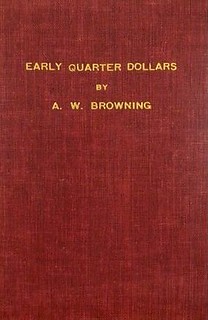 Though meticulously researched, largely accurate, and notably expansive—none of which are necessarily guaranteed in the world of numismatic literature—A.W. Browning's 1925 Early Quarter Dollars had a print run of just 55, including 5 in deluxe format. In the words of Walter Breen, it was
Though meticulously researched, largely accurate, and notably expansive—none of which are necessarily guaranteed in the world of numismatic literature—A.W. Browning's 1925 Early Quarter Dollars had a print run of just 55, including 5 in deluxe format. In the words of Walter Breen, it was the most perfect numismatic book written on the first try.
But with such quality and undeserved low production, the book quickly became a sought-after rarity (as numismatic bibliophiles know, this is not a problem unique to Browning, much to our frustration).
Copies remained scarce and largely inaccessible until 1950, when John J. Ford, Jr. helped ease the shortage a little. In an audio recording of the 1991 Numismatic Bibliomania Society Symposium, contributed by Wayne Homren and recently uploaded to the Newman Numismatic Portal, Ford described how he facilitated the production of 25-35 additional copies using the original 1925 glass negatives. (Note: The Symposium as a whole features Ford, John Adams, George Kolbe, Armand Champa, and P. Scott Rubin speaking for a shockingly concise 2 hours about numismatic literature). After gaining access to the original Browning negatives, Ford approached a firm on 45th Street in New York that he had encountered while schlepping coins from one dealer to another
to help him make 100 new prints from each glass plate. He then had the new plates trimmed and bound to the text elsewhere.
Ford himself in recollection was uncertain on the number of copies made, but knew there were 5 interleaved copies made in a crimson three-quarter morocco grained cloth with French marbled-paper sides. The other traditional reprints—of which 25-30 were issued, Ford didn't remember—were bound in a crimson cloth. Some deluxe interleaved copies were produced in full red calf, but it is unknown how many were made. Notably, all of the reprinted plates are considered higher-quality than the first edition. Charles Davis, in American Numismatic Literature, confirmed Ford's recollections, if not precisely, and reported 20-30 copies in cloth, five examples in crimson half morocco, interleaved, and an unknown quantity in full red calf, also interleaved. A copy of the cloth reprint sold for $425 in the John Adams library sale,
Ford advertised the new copies in January and February of 1951, and sold out. He distributed the copies on the day he started at New Netherlands Coin Company. Of course, Ford's copies did not satiate demand; later, larger reprints by Durst and Bowers & Merena mostly filled that gap. But Ford's reprints remain in demand today for their quality and, just a little, because Ford made them.
Image: Ford reprint of Browning's Early Quarter Dollars, in cloth
I located (or should I say "unearthed") several numismatic audio recordings while cleaning and organizing my office, library and garage over the pandemic lockdown. I was planning to send these and other materials to the Newman Portal for scanning when the University shut down. So they got set aside again until I recently rediscovered them. Many of these are presentations at meetings of the Western Pennsylvania Numismatic Society that I taped in the 1980s. One which another member must have given me was from 1972! Could a 50 year old tape be recovered and digitized? I passed these to Len Augsburger when we met for dinner at the recent Whitman Baltimore Expo. As it turns out, they could indeed be digitized, albeit with variable audio quality, as expected. Like Howard Carter opening King Tut's tomb, Len and Kellen were the first to hear these events in decades. Many thanks to Kellen for writing this up. Follow the link and give it a listen.
So do any of our readers have numismatic audio recordings to donate to NNP? Let us know! -Editor
Link to audio recording of 1991 Numismatic Bibliomania Society Symposium:
https://nnp.wustl.edu/library/multimediadetail/515004
VIDEO: ANTI-COUNTERFEITING EDUCATIONAL FOUNDATION
These are selections from the David Lisot Video Library that feature news and personalities from the world of coin collecting. David has been attending coin conventions since 1972 and began videotaping in 1985. The Newman Numismatic Portal now lists all David's videos on their website at:
https://nnp.wustl.edu/library/multimediadetail/522852
Here's one on the Anti-Counterfeiting Educational Foundation. -Editor
Anti-Counterfeiting Educational Foundation Protects Numismatic Consumers
VIDEO: 6:52.
Doug Davis, Director, Anti-Counterfeiting Educational Foundation,
David Lisot, Interviewer, CoinTelevision.com.
June 4, 2022.
The numismatic marketplace is being flooded with counterfeit coins. Coin consumers and collectors have never had a time that more caution was needed when a numismatic purchase took place. Doug Davis is Director of Anti-Counterfeiting of the Anti-Counterfeiting Educational Foundation. ACEF is a non-profit organization dedicated to providing consumers information about counterfeit coins. Doug explains where the coins are coming from, where they are being sold, and what collectors and dealers can do to protect themselves.
David adds:
"Counterfeit coins are a danger to the numismatic marketplace. Doug Davis is one of the good guys
with the support of the Professional Numismatists Guild to help with the problem."
An excerpt of the video is available for viewing on the Coin Television YouTube Channel at:
https://youtu.be/yR6TfZxp-sg
NOTES FROM E-SYLUM READERS: JUNE 19, 2022
More on Toning
"I was very pleased to see the correction submitted by Daryl Haynor. Toning
is caused by exactly what he describes: thin film interference. As contaminants react with the surface of the metallic silver coin, the layer of oxidation forms and progressively thickens. The result is that different thicknesses of tarnish interfere with different wavelengths of light, giving the color. In other words, different colors result from different thicknesses of the layer of tarnish, not from any kind of mint luster. As the toning progresses, the colors change, eventually turning black when the film is thick enough. This dark toning is considered terminal
by many, because so much of the surface has been oxidized (corroded) that the coin is no longer considered original
by the industry. Therefore, at some point, those toners
that are so prized by collectors these days will end up the color of tarnished silverware. That, of course, can be slowed by proper storage, but it can't be stopped."
I enjoyed Daryl's images so much I'm repeating both here. Thanks. -Editor
To read the earlier E-Sylum articles, see:
THOUGHTS ON IRIDESCENCE
(https://www.coinbooks.org/v25/esylum_v25n24a11.html)
VOCABULARY TERM: IRIDESCENCE
(https://www.coinbooks.org/v25/esylum_v25n23a15.html)
1967 Nebraska Centennial Medal Sculptor
Last week I asked about the designer of this nice Nebraska Centennial medal. -Editor
Shirley Johnson writes:
"Medallic Art Co. Catalog card (MACO # 1966-004) shows the following:
Sculptor: David Seyler"
Thanks! The askART site states that "David Warren Seyler (1917 - 2010) was active/lived in Nebraska, Ohio, California. David Seyler is known for Sculpture, ceramics, painting, teaching." -Editor
To read the complete artist entry, see:
Artist Biography & Facts
David Seyler
(https://www.askart.com/artist/David_Warren_Seyler/102147/David_Warren_Seyler.aspx)
To read the earlier E-Sylum article, see:
NUMISMATIC NUGGETS: JUNE 12, 2022
(https://www.coinbooks.org/v25/esylum_v25n24a19.html)
Query: 1875 William Douglas Auction Sale
Dave Hirt writes:
"While looking through my library I came across a box of miscellaneous items that I had not looked at for a long time. one item in there was a coin price list by William Douglas of Zanesville, Ohio dated 1875. The only listing of this catalog I can find anywhere is in Attinelli's book on numismatic auction catalogs, page 101. The copy that I own is the only one I ever saw offered for sale. Perhaps our great readers might have some information on this catalog."
Can anyone help? -Editor
Query: Anna Coleman Ladd Medal
Website visitor Cyril Hofstein of France writes:
"I've found your articles on the medal work of Anna Coleman Ladd. Please find a picture of another medal, quite rare, I suppose."
Can anyone provide more information on the rarity and value of the medal? -Editor
To read the earlier E-Sylum articles, see:
SCULPTOR ANNA COLEMAN LADD
(https://www.coinbooks.org/esylum_v17n40a22.html)
NOTES FROM E-SYLUM READERS: OCTOBER 5, 2014 : Medals By Anna Coleman Ladd
(https://www.coinbooks.org/esylum_v17n41a12.html)
Martha Washington Speaks
Ron Guth writes:
"While falling down one of the many rabbit holes on the Internet, I came across a site that has a new tech that quickly and easily colorizes old black-and-white images. They also allow users to animate images and create animated "deep stories". It doesn't work that well with coin images but, with some finagling, I was able to create a deep story for Alice Paul."
To read the earlier E-Sylum article, see:
Alice Paul's DeepStory
Created by Ron Guth
Ron also posted a new video on YouTube using the new Deep Stories technology to bring Martha Washington to life. Very cool. Check it out. -Editor
Using new technology, Martha Washington describes her life and talks about some of the coins that bear her image.
To watch the full video, see:
Ron Guth on Coins #9 - Martha Washington Speaks
(https://youtu.be/z8pklAk0vYs)
Christian Gobrecht on NPR's "Planet Money" Podcast
Dennis Tucker writes:
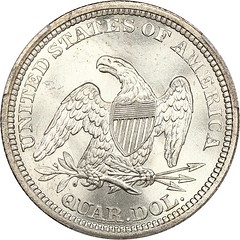 "NPR's
"NPR's Planet Money
ran a listener Q&A segment last week. It's an interesting segment with some purely financial questions (e.g., Are we in a recession?
) but also some numismatic questions.
"I was approached by one of the podcast's producers, Dave Blanchard, a few weeks ago, to answer a question about coin denominations --- specifically, why America's circulating coins are spelled out (e.g., QUARTER DOLLAR) rather than abbreviated (e.g., 25 C.). Our conversation got into the influence of Christian Gobrecht in the 1830s and ended with the latest American Women quarters.
"That portion starts at 14:55 and ends at 19:33.
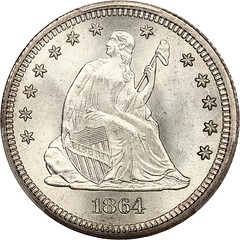 "During a break while Blanchard was interviewing me, for some background information I picked the brain of Len Augsburger, well known to Christian Gobrecht fans as president of the Liberty Seated Collectors Club. As I later mentioned to Len, the finished segment shines a bright light on Gobrecht as the designer of the Liberty Seated motif. One could argue that Mint Director Robert Patterson also deserves some credit for its inspiration. But as a numismatic piece geared toward a non-numismatic audience (and a couple hours of in-depth conversation boiled down to a few minutes of podcast), I think it does a solidly entertaining job exploring this area of U.S. coins."
"During a break while Blanchard was interviewing me, for some background information I picked the brain of Len Augsburger, well known to Christian Gobrecht fans as president of the Liberty Seated Collectors Club. As I later mentioned to Len, the finished segment shines a bright light on Gobrecht as the designer of the Liberty Seated motif. One could argue that Mint Director Robert Patterson also deserves some credit for its inspiration. But as a numismatic piece geared toward a non-numismatic audience (and a couple hours of in-depth conversation boiled down to a few minutes of podcast), I think it does a solidly entertaining job exploring this area of U.S. coins."
Very cool - check it out. -Editor
To listen:
On The Case: Recession, Formula, and Greenbacks
(https://www.npr.org/2022/06/08/1103831666/on-the-case-recession-formula-and-greenbacks)
Coins in Vending Machines and Propaganda Posters
Here are a couple interesting items I came across this week on Reddit. The Coin Hunt vending machine was "in the Sinclair Station south of Worthington, MN." and another reader reported a similar one in Missouri. The item on coins in war propaganda posters has a number of great images. -Editor
To read complete discussion threads, see:
Spotted this coin vending machine in the Sinclair Station south of Worthington, MN.
(https://www.reddit.com/r/coins/comments/vak6b5/
spotted_this_coin_vending_machine_in_the_sinclair/)
Coins in WWI propaganda posters (and one from WWII)
(https://www.reddit.com/r/coins/comments/vbbxk6/
coins_in_wwi_propaganda_posters_and_one_from_wwii/)
A couple years ago Jeff Garrett alerted us to an exhibit of similar posters at the Smithsonian. -Editor
To read the earlier E-Sylum article, see:
NOTES FROM E-SYLUM READERS: DECEMBER 13, 2020 : Austrian World War I poster
(https://www.coinbooks.org/v23/esylum_v23n50a12.html)
ORIENTAL NUMISMATIC SOCIETY 50TH CONFERENCE
The Oriental Numismatic Society is holding its 50th anniversary conference on Zoom, 25–26th June 2022. Conference organizers and chairs include: Pankaj Tandon, Helen Wang, Shailendra Bhandare, Joe Cribb, Robert Bracey, and Paul Stevens. Speakers and their talks are listed below - see the ONS website for details. -Editor
Indo-Sasanian coinages: interpretive
challenges and new ways forward
John Deyell
Chinese coin culture
Dai Jianbing
The circulation and use of the bamboo
tallies in Jiangsu Province by the light of
the Tongcheng Company issues
François Thierry
Cataloguing the ancient Annamese
private cash
François Joyaux
Fresh light on the copper coins of
Vemakis
Amiteshwar Jha
The coins in the name of Chandragupta
Pankaj Tandon
From Bishapur to Vienna: A hoard of late
Sasanian drachms?
Ehsan Shavarebi
Immobilized types in Sogdian coinage
Aleksandr Naymark
Islam Mints and Urban Dynamics – Baghdad,
al-Raqqa, and Other Places
Stefan Heidemann
Badshah as the Caliph: Probing caliphal
pretensions of the Mughal rulers of India
Sanjay Garg
A biography in banknotes: The life and
career of Alfred Joseph Bull, 1876-1950
Richard Morel
Bombay tolas
Michael Mitchiner
For more information on the conference, see:
Conference program
(https://www.orientalnumismaticsociety.org/meetings/ons-50th-conf.pdf)
Conference synopses
(https://www.orientalnumismaticsociety.org/meetings/ons-50th-synopses.pdf)
For more information on the Oriental Numismatic Society, see:
https://www.orientalnumismaticsociety.org/
THE DEMISE OF WOMEN IN NUMISMATICS
Not really - women in numismatics rock, but the organization created by and for them three decades ago is calling it quits. -Editor
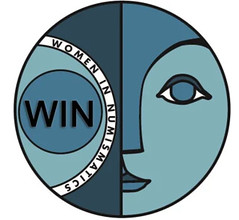 After more than 30 years of service to the numismatic community, WIN has accomplished its mission and achieved the goals it set for itself. With some sadness but also pride in what the dedicated members and officers of WIN have achieved over the years, the WIN Board of Directors has decided to dissolve Women in Numismatics as of December 31, 2022.
After more than 30 years of service to the numismatic community, WIN has accomplished its mission and achieved the goals it set for itself. With some sadness but also pride in what the dedicated members and officers of WIN have achieved over the years, the WIN Board of Directors has decided to dissolve Women in Numismatics as of December 31, 2022.
Women in Numismatics was formed in 1991 as a national non-profit organization that provided a networking and educational forum for female numismatists. Members included new and established collectors, dealers and those associated with numismatic-related organizations. WIN encouraged fellowship among its members and promoted education through guest speakers and informative presentations. WIN also provided educational opportunities to its members by awarding an annual scholarship to the ANA's Summer Seminar in Colorado Springs.
WIN will hold a final special awards meeting during the ANA's World's Fair of Money show on Wednesday, August 17, 2022, at 8:00 a.m. in Room 11 of the Donald E. Stephens Convention Center in Rosemont, Illinois.
To read the complete article, see:
Women in Numismatics Press Release
(https://www.womeninnumismatics.com/)
THE DEMISE OF LIVE AUCTIONS?
Back on May 8, 2022 I asked, "So did everyone notice this in the Heritage May 3, 2022 Coin News?" -Editor
Important: All auctions until further notice will be online only. Take advantage of our high resolution images and videos to place bids up until the live event, and then continue to bid during the Heritage Live auction event, including live streaming audio and video.
In his Editor's Preface to the upcoming issue of the Journal of Early American Numismatics (JEAN), Chris McDowell discusses the issue. -Editor
 Before I discuss the contents of this issue, I want to discuss another topic. Something is missing from my numismatic life—the live, in-person coin auction. Do you remember it? I lament what I fear shall be the end of the age of the in-person coin auction. Nothing can compare to the thrill of being in a room with my fellow collectors bidding on colonial coins. The last vestige of the live numismatic auction may be the colonial coin auction. We are the only group that still attends such events with gusto. Rumor has it that the auction houses have determined that profits can be increased by eliminating these gatherings and turning them into computer-operated events robotically run out of the home office back in Kalamazoo or some other such place. This may seem like an improvement or progress to some, but with COVID, we have lost a sense of community and physical contact with our coin-collecting friends. Like so much else that I was initially told were temporary changes with this pandemic, the loss of the in-person auction in conjunction with a large coin show may now be a thing of the past. I already miss holding up my number and hearing Jeff Rock tell me that I'm bidding on the wrong lot again or,
Before I discuss the contents of this issue, I want to discuss another topic. Something is missing from my numismatic life—the live, in-person coin auction. Do you remember it? I lament what I fear shall be the end of the age of the in-person coin auction. Nothing can compare to the thrill of being in a room with my fellow collectors bidding on colonial coins. The last vestige of the live numismatic auction may be the colonial coin auction. We are the only group that still attends such events with gusto. Rumor has it that the auction houses have determined that profits can be increased by eliminating these gatherings and turning them into computer-operated events robotically run out of the home office back in Kalamazoo or some other such place. This may seem like an improvement or progress to some, but with COVID, we have lost a sense of community and physical contact with our coin-collecting friends. Like so much else that I was initially told were temporary changes with this pandemic, the loss of the in-person auction in conjunction with a large coin show may now be a thing of the past. I already miss holding up my number and hearing Jeff Rock tell me that I'm bidding on the wrong lot again or, you need to keep going.
At the Gleckler auction in November 2016, I had already accumulated 299
different Connecticut copper varieties. As the lots ticked by, I set my sights on lot number 5354, the 1787 Miller 56-XX. I determined that it would be my 300th Connecticut variety. Everyone around me knew what was going on. When the hammer came down, and I was the winner, I stood up, and everyone clapped. All my friends shook my hand, slapped me on the back, and congratulated me. A few weeks later, I received a package from Stack's; inside was a framed photograph of my 56-XX with 300
printed under it. How would this moment have been if, instead, I was at home by myself in front of my computer screen? I dare say, not the same; not nearly the same. Many of you must have similar memories. Let us hope that the rumors are untrue and that COVID has not snatched this great institution from us as it has so much else.
What do readers think? While the cost savings and efficiencies of online bidding are numerous, something is definitely lost without live, in-person bidding. The high-end fine art auction houses have long melded the two. While every single auction may no longer merit in-person bidding, let's hope it doesn't disappear from the scene completely. -Editor
To read the earlier E-Sylum articles, see:
THE FUTURE OF LIVE AUCTIONS
(https://www.coinbooks.org/v24/esylum_v24n52a17.html)
WAYNE'S WORDS: THE E-SYLUM MAY 8, 2022
(https://www.coinbooks.org/v25/esylum_v25n19a01.html)
VOCABULARY TERM: JEWELRY FINISH
Here's another entry from Dick Johnson's Encyclopedia of Coin and Medal Terminology. -Editor
Jewelry Finish. A surface on medallic items which has been finished by any of several methods commonly employed in the jewelry industry. A common description is "letter tops polished." They are not as satisfactory or as permanent as finishes applied by more standard "medallic" methods. Jewelry finishes usually contain several portions (as lettering, relief or edges) of highly polished areas or brightcut areas often contrasted with satin backgrounds. A typical item might be goldplated, lightly sandblasted to acquire the satin background, then chosen areas highly buffed with jeweler's rouge to obtain the polished surface (bright finish). The process then continues: wash, dry, bake and lacquer.
For large medals, jewelry manufacturers like to polish the edge and often the rims of a medal. This makes the edge smooth (and susceptible for dropping). It is against the rules of standard medal manufacturers who purposefully design the rims and edges for aiding the human fingers to grip the piece more so. The existence of jewelry finish on a medallic item would indicate it was manufactured by a jewelry maker rather than a typical medal manufacturer. See finishing and finishing, brightcut, polished edge.
Interesting tidbit about the edge! I never thought about the gripping issue, but it makes perfect sense. -Editor
To read the complete entry on the Newman Numismatic Portal, see:
Jewelry Finish
(https://nnp.wustl.edu/library/dictionarydetail/516182)
DONALD PAUL TAXAY (1933-????)
American Numismatic Biographies author Pete Smith submitted this article on numismatic author Don Taxay. Thanks! -Editor
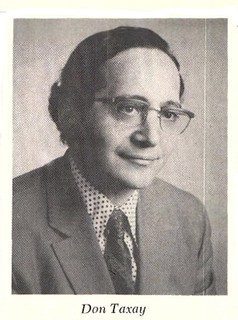 Occasionally I go back to old biographies to see if I might find additional information. This week
my subject is the mysterious Don Taxay.
Occasionally I go back to old biographies to see if I might find additional information. This week
my subject is the mysterious Don Taxay.
Donald Paul Taxay was born in Chicago on May 24, 1933. His parents were Russian immigrants Julius and Ruth Weller Taxay. He graduated from the American Conservatory of Music.
Taxay became interested in advanced spiritual consciousness early in life. By 1956 he was corresponding with Indira Devi, disciple of Sri Dilip Kumar Roy (1897-1980), the founder of the Hari Krishna Mandir Ashram at Poona, India. He travelled to India as early as 1960 and took on the name Prashanta.
He entered the coin business in 1958 as manager of the leased coin department within the Jordan Marsh Department Store in Boston. He did not last long at any of his numismatic jobs.
Taxay worked as manager of the Royal Athena Coin Galleries in New York. Later he worked with John J. Ford, Jr. and Walter Breen at New Netherlands Coin Company. He and Breen formed the Institute of Numismatic Authenticators in 1963. He served as curator for the Chase Manhattan Bank Money Museum for two years from April 1964 to May 1966. He left to conduct an authentication and appraisal service in New York City.
In 1969 he joined William Thomas Anton, Jr. to write catalogs for Harmer Rooke. At the time he was using the name D. Paul Taxay. Then he joined Harry Foreman with Foreman, Taxay and Associates in 1974. In 1975 he was appointed senior vice president of First Coinventors, Inc. and director of their Colonial American Coin Club. He was not a good fit and soon terminated.
He formed a corporation, Rare Coin Collectors Co-op, Inc, on July 8, 1976. The business address was 700 Summer Street, Stamford, Connecticut 06901. The corporation had a dissolution date of December 30, 1977.
Taxay wrote a series of five books that were important references in their time and remain relevant today. The first was Counterfeit, Mis-struck, and Unofficial U.S. Coins, A Guide for the Detection of Cast and Struck Counterfeits, Electrotypes and Altered Coins (1963). The second was my favorite, The U. S. Mint and Coinage (1966). This was followed by An Illustrated History of U. S. Commemorative Coinage (1967). Then came Money of The American Indians and Other Primitive Currencies of the Americas (1970). Finally came The Comprehensive Catalogue and Encyclopedia of United States Coins published in 1971. A second edition was published in 1976. Five books published over the span of eight years while conducting his coin business is a remarkable accomplishment.
Karl Moulton was highly critical of Taxay and the U. S. Mint book. In the January 1, 2006, issue
of The E-Sylum. Moulton wrote, he didn't do enough original research, but simply followed the
ABC's of misinterpreting the facts. This would be Accepting, Believing, and Copying from
others without first validating their claims.
Moulton's passing is still fresh in our minds. I believe with the passage of time, his work may be
subject to the same criticism.
Don Taxay (age 44) married Constance Connie
Ferris (age 35) at Stamford, Connecticut, on
Christmas Day in 1977. They were divorced on April 12, 1982. Constance A. Ferris (5/2/1942-10/6/2009) died in Greenwich, Connecticut. Her life dates fit.
This brings us to the disappearance of Taxay around the time of his 1977 marriage. Various numismatists have commented on his disappearance. One story is that he was a Hare Krishna and travelled to Poona, India, to meet with Bhagwan Shree Rajneesh (1931-1990). He returned to the United States and sold off his library before returning to India.
Perhaps he went to Poona as a follower of Sri Dilip Kumar Roy rather than Bhagwan Shree Rajneesh. Most American numismatists would not know the difference.
Another story is that he married a wealthy woman and moved to Florida. His 1977 marriage supports this story and contradicts the concept that he sold of his belongings to disappear in India.
Julia Casey found an article in The Tampa Tribune of November 23, 1979, that quotes Donald
Taxay on his move to Lakeland, Florida, all the usual reasons – no state income tax, low
property taxes and nice weather.
Later he said, My wife thinks she's going to get a Shetland
pony because we're zoned farming down there.
The Familysearch website indicates that Donald P. Taxay was a resident of Stamford, Connecticut, from September 1, 2005 until August 6, 2008. These records are frequently inaccurate but may be a clue that he was in Stamford at some time after 1977.
So, there appear to be two conflicting stories. Perhaps he sold all his worldly possessions to meditate in India, or perhaps he retired to Florida to enjoy the weather and buy a pony.
Sometimes the lack of evidence is evidence. With no record of activity in the past forty years, it is likely that he was out of the country. It is also likely that he died while out of the country.
THE LUCINDA WALKER SILVER DOLLAR
Classical Numismatic Group is offering an early dollar featuring some interesting graffiti. Here's the press release. -Editor
The discovery of a tiny set of letters hand-engraved on a vintage
U.S. silver dollar, and detective work by a sharp-eyed coin specialist, has opened a window into
a uniquely American tragedy – the Trail of Tears
1830-1850, when Native Americans of the
Cherokee nation and other tribes were forcibly relocated from their fertile ancestral homelands to
barren tracts of land west of the Mississippi.
The coin, a draped bust U.S. silver dollar dated 1797, 10 X 6 stars variety, graded Fine Details, graffiti by NGC (6461819-003), is featured in Classical Numismatic Group LLC's Electronic Auction 520, closing Wednesday, July 20, 2022.
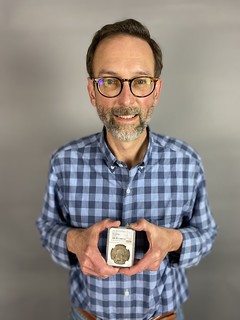 Jeff Rill, numismatist and auctioneer with Lancaster PA-based CNG, was cataloguing the
well-worn dollar when he noticed what looked like old graffiti on both sides of the coin.
Jeff Rill, numismatist and auctioneer with Lancaster PA-based CNG, was cataloguing the
well-worn dollar when he noticed what looked like old graffiti on both sides of the coin. I
carefully examined the graffiti, recording each letter singly, and then looked at what it spelled
out,
Rill said.
The graffiti on the obverse read Lucinda Walker
in neat, careful script. Curious, Rill
began researching known individuals of that name from the early 1800s, when a coin such as this
would have been in circulation.
He discovered that there was someone of this same name in the historical record – a woman whose bloodline included both Native Americans and American settlers of European stock. This Lucinda Walker, born Lucinda Taylor, was the daughter Chief Richard Fox Taylor of the Cherokee Nation and his wife, Susan Taylor, of European ancestry.
Lucinda was born circa 1834 in the Old Cherokee Nation. She married a cousin, John Osborn Walker circa 1854. According to the Eastern Cherokee application of her only child, daughter Emily, born 19 November 1855, the family lived in the Tahlequah District (family #259 on the Cherokee Drennan Roll) where Lucinda died in 1859 at the age of 25. Her cause of death at so early an age is not recorded.
While the graffiti on the obverse makes this an interesting possibility of the person's
identity, the graffiti on the reverse makes this identification more compelling,
Rill said.
On the reverse, below the wings of the eagle, are the letters N
and Mc.
The half-sister of Lucinda's father was Nellie McDaniel, who married a white settler, James McDaniel.
To have the names and initials of two closely-related people who lived in the proper era on the
dollar, I believe, securely ties this coin to Lucinda Walker of the Cherokee Nation,
Rill said.
How the coin came to be engraved with these two names cannot be known for certain,
but Rill had a plausible theory: It is possible that Lucinda's father's half-sister had this silver
dollar personalized and engraved with her married name as a wedding present upon Lucinda's
marriage,
he said. A silver dollar at that time would have been a considerable amount of
money, roughly $35 in today's value, and so would have been a proper gift.
Also, U.S. draped
bust silver dollars, minted 1795-1803, were quite rare and collectible even in the early 1800s.
Lucinda Taylor would have been about 4 years old when her father, Chief Richard Fox
Taylor, served as a conductor
in the removal of the Cherokee Nation from their home in the
Mississippi Valley to the Oklahoma territory in the spring through winter of 1838. Conductors
were tribal leaders chosen to lead roughly 1,000-person detachments of Cherokees on the 770-
mile journey, which took more than 100 days to complete. Though born Cherokee, Taylor had
served as a volunteer guide in the U.S. military under Captain Gideon Morgan in 1814-1815
Creek War. He later served as Cherokee delegate to Washington D.C. and was elected Assistant
Principal Chief of the Cherokee Nation, serving from 1851-1853.
The Trail of Tears
was a two-decade process, starting with President Andrew Jackson's
Indian Removal Act of 1830, by which more than 60,000 Native Americans of five different
nations were forcibly removed from their homelands in the rich Mississippi Valley to far more
barren lands hundreds of miles to the west. Little Lucinda would certainly have been part of that
episode, and it is difficult at this remove to think about what hardships she and her family might
have endured, even though her father, Chief Taylor, was favored by the U.S. government.
The coin is part of a larger consignment from the Hendin Family Collection, assembled over decades by Aaron Hendin, MD (1918-1990), father of David Hendin, himself a collector of ancient coins and author of the popular Guide To Biblical Coins series of numismatic books.
The Lucinda Walker Silver Dollar
is in CNG Electronic Auction 520, which goes
live
on CNG's popular website,
www.cngcoins.com, on Thursday, June 30, and closes three
weeks later, Wednesday, July 20. For further inquiries, contact Jeff Rill at
jeff@cngcoins.com.
THOMAS URAM RECIEVES ANA KRAUSE AWARD
The ANA has chosen an eminently worthy recipient of their newly-renamed top award. The this year's convention Tom Uram will recieve the Chester L. Krause Memorial Distinguished Service Award. here's the press release. -Editor
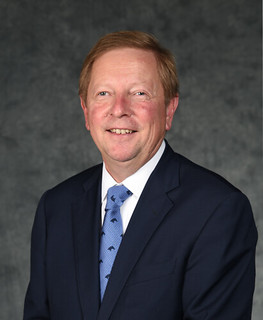 Thomas Uram, a dedicated promoter of numismatics, is the recipient of the first-ever Chester L. Krause Memorial Distinguished Service Award, the American Numismatic Association's (ANA) highest honor.
Thomas Uram, a dedicated promoter of numismatics, is the recipient of the first-ever Chester L. Krause Memorial Distinguished Service Award, the American Numismatic Association's (ANA) highest honor.
The award will be presented at the Chicago World's Fair of Money® (August 16-20). The ANA Board of Governors made the decision to rename the accolade – formerly known as the Farran Zerbe Memorial Award for Distinguished Service – at its April meeting to honor the memory and contributions of the renowned numismatic publisher and to name Uram as its first recipient.
Uram has been a stalwart supporter not only of the hobby, but of the ANA, which he joined as a Young Numismatist in 1974, and of the Pennsylvania Association of Numismatists (PAN), of which he is currently the president. He has served on the ANA board, as chair of two ANA committees, and as the assistant host club chair for the Pittsburgh World's Fair of Money.
In 2012, the Pennsylvania resident was appointed to the United States Mint's Citizens Coinage Advisory Committee (CCAC). According to former United States Mint Director David J. Ryder, Uram's enthusiasm for numismatics and his efforts to strengthen the interface between the Mint and the ANA have been unceasing
and resulted in an elevated relationship between the two organizations.
According to Ryder, Uram was instrumental in the passage of the 1921 Silver Dollar Coin Anniversary Act, which authorized the minting of 2021 Morgan and Peace dollars. It was Tom who first brought this important coin program to my attention, and his leadership was the single most driving force in getting this legislation passed,
said Ryder. I can think of no contribution more meaningful to numismatics today.
A collector of U.S. 2-cent pieces, medals and "curved" coins, Uram is the recipient of numerous numismatic awards recognizing his dedication to the hobby:
- ANA Presidential Award (2011)
- Radford Stearns Memorial Award for Achievement in Exhibiting (2014)
- Radford Stearns Memorial Award for People's Choice exhibit (2015)
- Numismatic Ambassador (2017)
- ANA Glenn Smedley Memorial Award (2019)
- ANA Medal of Merit (2020)
A more detailed article about Tom Uram and his contributions to the hobby will appear in the August issue of The Numismatist, the official publication of the ANA.
For more information on ANA service awards, see:
ANA Service Awards
(https://www.money.org/american-numismatic-association-awards)
To read the earlier E-Sylum article, see:
TOP ANA AWARD NAMED FOR CHESTER L. KRAUSE
(https://www.coinbooks.org/v25/esylum_v25n18a19.html)
ANA PHILANTHROPY AWARDS: BOWERS, STACKS FAMILY
This ANA press release announces the ANA's Philanthropy Awards for 2022. -Editor
The American Numismatic Association (ANA) will recognize Q. David Bowers and the Stack family at the Chicago World's Fair of Money® (August 16-20) for their trailblazing successes in the numismatic community with its Philanthropy Award. This award publicly honors and recognizes substantial contributions donated to the Association in support of its strategic mission that helps to further expand, enhance, and sustain the hobby.
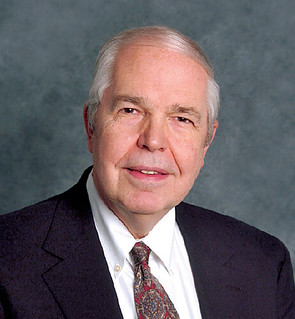 Q. David Bowers is widely recognized as one of the most scholarly and prolific numismatic writers of the past half century. His maternal grandfather sparked his interest in coins when he gave him an 1893 Columbian half dollar. A local tax collector later showed a young Bowers a 1909-S VDB Lincoln cent, which was worth $10, a large sum at the time.
Q. David Bowers is widely recognized as one of the most scholarly and prolific numismatic writers of the past half century. His maternal grandfather sparked his interest in coins when he gave him an 1893 Columbian half dollar. A local tax collector later showed a young Bowers a 1909-S VDB Lincoln cent, which was worth $10, a large sum at the time.
During the 1950s – when he was a teenager – Bowers became a dealer and placed advertisements in a local paper. His business grew, and he continued to work as a dealer while attending Pennsylvania State University, graduating with honors in 1960.
Since then, he has taken an active role as a cataloger and professional numismatist, cofounding the auction house Bowers & Ruddy (later, Bowers & Merena). The author of hundreds of auction catalogs and articles, he has written more than 40 books on a wide variety of topics, receiving more Book of the Year Awards
and Best Columnist
honors from the Numismatic Literary Guild (NLG) than any other writer. In 1989 he received the NLG's highest honor, the Clemy Award.
Bowers has been a loyal supporter of the ANA for many years. His most valuable work on behalf of the ANA is the definitive, 1,744-page American Numismatic Association Centennial History, which involved hundreds of hours of research. Bowers has assisted the Association financially, professionally, and culturally. Through the years, he has shared his invaluable experience as a Summer Seminar instructor, spoken at ANA conventions, participated in educational forums, and written a monthly column and many feature articles for The Numismatist.
Elected to the ANA's Board of Governors in 1979, Bowers served for six years, including a term as president from 1983 to 1985. He also served as president of the Professional Numismatists Guild (PNG).
Bowers has received many accolades for the countless contributions he has made to the hobby during his nearly 70 years in numismatics. His efforts to promote a greater understanding of our nation's coinage and its place in American history, society, and culture have earned him many ANA awards. He became a Century Club member in 1980 and a Medal of Merit winner in 1987. In 1991 he was presented with the Association's highest honor, the Farran Zerbe Memorial Award for Distinguished Service (now named the Chester L. Krause Memorial Distinguished Service Award). Three years later, he was inducted into the Numismatic Hall of Fame.
Bowers became the first recipient of the Numismatist of the Year award in 1995, and was honored with a Presidential Award in 1997, an Exemplary Service Award in 2003, and a Lifetime Achievement Award in 2005. He has also lectured at Harvard University and appeared on The Today Show and other network and cable-television programs. He has cataloged many of the finest collections ever assembled, including the Eliasberg Collection, the Norweb Collection, the Garrett Collection, and the Harry W. Bass, Jr. Collection.
In his final Coins & Collectors
column published in the December 2021 issue of The Numismatist, Bowers writes that it has given him great joy to be at the heart of the hobby, to have served many clubs and professional organizations, and to have written countless books and columns that spread the love for this great pursuit.
At 83 years old, Bowers is enjoying a more relaxed schedule with fewer deadlines. But the lifelong collector says he will never be finished with numismatics.
The Stack family has not only managed the sale of some of the most magnificent numismatic pieces known, but they have also generously contributed to the ANA. Brothers Joseph B. and Morton Stack established Stack's in New York City in 1933 and conducted its first public sale two years later. Their firm quickly grew to become one of the most important numismatic dealerships in America.
The Stacks specialized in everything numismatic – coins, tokens, medals, and paper money – and their services were in high demand. Many sought their expertise, including universities, royalty, government institutions, collectors, and other dealers. Josiah K. Lilly, the well-known pharmaceutical executive, commissioned Stack's to build his collection. Now in the Smithsonian Institution, it is the National Numismatic Collection's greatest donation to date.
Eventually, Joseph and Morton passed ownership of the company to their sons, Norman, Harvey, and Benjamin. Harvey became the company's main spokesman and welcomed visitors to its New York City gallery and participated in hobby activities. He contributed many of his recollections to Stack's website, and his musings (entitled Harvey Stack Remembers
) contain a wealth of information about the company.
Harvey worked full-time for Stack's for 62 years, retiring in 2009 as chief manager of business affairs. During that time, it is said that he conducted more auction sales than anyone in the numismatic industry. He perhaps is best remembered for his testimony before Congress in 1995, in which he appeared before the U.S. House Banking Committee to talk about the loss of public interest in the U.S. Mint's modern commemorative programs. At the meeting, he suggested the issuance of five quarter designs each year. His idea inspired the 50 State Quarters® program, which proved popular and revitalized the hobby for a new generation of collectors, in addition to bringing hundreds of millions of dollars of profit to the U.S. Treasury.
Harvey's son Lawrence (Larry
) joined the firm in 1973 and was responsible for bringing to the company many significant holdings, including the John J. Ford Collection. Larry became internationally known for his expertise and all-around knowledge.
The Stack family was instrumental in building some of the greatest assemblages of their time, and they cultivated relationships with esteemed collectors to grow the hobby nationwide. Harvey also fought for clearer import regulations on coins purchased overseas and worked with the ANA and other professionals to develop a standardized grading system for coins.
In 2011 Stack's merged with Bowers & Merena to form Stack's Bowers Galleries, one of the top numismatic auction firms in the country. The company continues the Stack family's legacy of presenting important numismatic cabinets and realizing record-breaking prices.
Harvey Stack was a longtime ANA supporter, and his firm has served as the official auctioneer at numerous Association conventions. He remained involved in the business until his death on January 3, 2022, sharing the company's history, mentoring staff members, and maintaining his relationships within the hobby.
The Stack family received the Medal of Merit in 1982 and Lifetime Achievement Award in 2010. Harvey was named the 1997 Numismatist of the Year. In 1990-91 he served as president of the PNG, which gave him its Lifetime Achievement Award.
LONG BEACH EXPO, JUNE 30-JULY 2, 2022
This press release discusses attractions at the upcoming Long Beach Expo. -Editor
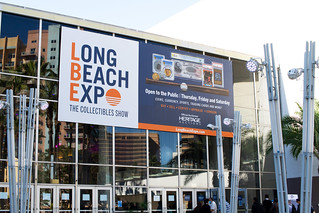 The Long Beach Coin, Currency, Stamp & Sports Collectible Show (www.LongBeachExpo.com) unfolds at the Long Beach Convention Center in Long Beach, California, June 30 through July 2, 2022. One of the biggest collectibles shows on the West Coast is headlined by a multimillion-dollar Heritage Auctions event and brings hundreds of dealers, an exciting array of attractions, Meet the Expert sessions with collectibles experts, a comprehensive speaker series, on-site grading of coins and sports cards, a treasure hunt for kids, giveaways, and much more.
The Long Beach Coin, Currency, Stamp & Sports Collectible Show (www.LongBeachExpo.com) unfolds at the Long Beach Convention Center in Long Beach, California, June 30 through July 2, 2022. One of the biggest collectibles shows on the West Coast is headlined by a multimillion-dollar Heritage Auctions event and brings hundreds of dealers, an exciting array of attractions, Meet the Expert sessions with collectibles experts, a comprehensive speaker series, on-site grading of coins and sports cards, a treasure hunt for kids, giveaways, and much more.
It's always great to be back at the Long Beach Expo, just a short drive away from the Professional Coin Grading Service headquarters in Santa Ana,
says Professional Coin Grading Service (PCGS) President Stephanie Sabin. Some of the biggest action of the year occurs at the Long Beach Expo, where thousands of coin collectors and enthusiasts of many other collectibles hobbies come together to buy, sell, trade, learn, and explore. Among the main attractions will be the exhibition of John Q Little's All-Time Finest Standing Liberty Quarter Collection, featuring quarters that were struck from 1916 through 1930 and are considered by many among the nation's most beautiful coins.
Other highlights include four Meet the Expert sessions where the public can find out what their coins, banknotes, collectible cards, and video games are worth. It's a thrill to have four Meet the Expert sessions at the Long Beach Expo,
remarks PCGS Senior Event Manager Samantha Dark. We have something for virtually everyone here at the Long Beach Expo, including the chance for collectors to submit their coins and collectible cards for grading right here at the show, chances to win coins and sports collectibles, a variety of educational speakers, a treasure hunt with prizes for young attendees, and an amazing talented face painter.
She adds, the Long Beach Expo is a true destination for camaraderie and fun.
Below is a complete list of attractions for the June 30-July 2 Long Beach Expo:
- Heritage Auctions sale of rare coins
- Onsite grading of coins, banknotes, trading cards, and memorabilia from PCGS and Professional Sports Authenticator (PSA)
- Kids' Treasure Hunt with prizes on Saturday, July 2, 2022
- Giveaways of valuable coins, banknotes, and sports collectibles
- John Q Little's All-Time Finest Standing Liberty Quarter Exhibit Coin Grading Competition
-
Meet the Expert sessions with –
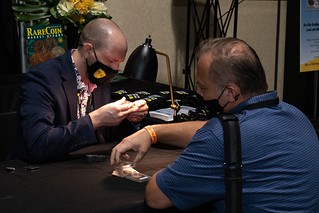
- Steve Feltner, PCGS Director of Numismatic Education & Grading Team Leader
- Philip Thomas, PCGS Banknote Specialist & Research Manager
- Dan Wulkan of Memory Lane
- Dan Gomez, WATA Games Head of Research and Authentication
- Educational speaker series covering a wide array of collectibles topics
- Kids Zone with activities for young attendees
- Face painting by professional Long Beach artist Shawna Del Real from Face n' Body Art
- And much more
*Check the attractions page (www.longbeachexpo.com/visitors/attractions) for times/dates of individual attractions.
Additionally, PCGS is offering a banknote on-site grading special allowing submitters to take advantage of show turnaround times and pay only $45 per note when submitting five or more qualifying notes for Regular Service on-site. More information can be found at https://www.pcgs.com/shows/detail/6703.
PCGS Collectors Club membership is required for all submissions, so those who are not members can join ahead of the event and also enjoy free admission to all Long Beach Expos by visiting https://www.pcgs.com/join.
PSA will be offering on-site card grading Thursday and autograph authentication Friday and Saturday. They will also be accepting Take-Home Submissions for trading cards, unopened packs, tickets, autographs, memorabilia, and more. For more information on available PSA services, submission guidelines and fees, visit https://www.psacard.com/resources/showdetail/440.
The Long Beach Expo will be held from June 30 and runs through July 2. Doors open 10 a.m. through 5:30 p.m. on Thursday, June 30, and Friday, July 1, and 10 a.m. through 4:30 p.m. on Saturday, July 2. The Long Beach Expo will take place at the Long Beach Convention Center – Hall C, 100 S. Pine Avenue, Long Beach, California 90802.
KEUNKER 2022 SUMMER AUCTION SALE 368
The following articles consist of material from the press releases for Künker's 2022 Summer auction sales 368-371. It's a delight to see so many interesting coins and medals coming to the market. Some of these are stunning pieces of art and workmanship. -Editor
Saxonia in Nummis, the collection of the Berlin savings bank with rarities from Brandenburg-Prussia, gold coins from the Köhlmoos Collection and the Liska Collection with Czechoslovak gold coins – these are just a few of the private collections on offer at Künker's Summer Auction Sales.
Four catalogs with 3,124 lots and a total estimate of 7.7 million euros – that's the material of Künker's Summer Auction Sales, which will be held from 20 to 24 June 2022. Three of the catalogs are dedicated to one impressive collection each. Catalog 368 contains the first part of the Dr. Walter Kemlein Collection with Saxon coins and medals, catalog 369 is dedicated to the collection of the Berlin savings bank including great rarities from Brandenburg-Prussia and rare issues of the German Empire. Catalog 370 deals with German gold and silver coins from the Köhlmoos Collection and catalog 371 combines the material of many private collections, including the Dr. Pavel Liska Collection of Czechoslovak gold coins and a special collection Venezuela.
Catalog 368: Saxonia in Nummis – The Dr. Walter Kemlein Collection The collection of Saxon coins, medals and decorations built by Dr. Walter Kemlein over about half a century consists of more than 3,500 objects. The first part of this collection marks the beginning of Künker's Summer Auction Sales 2022 as auction 368. The material covers a time frame ranging from the bracteates of the Margraviates of Wettin and Meißen via the Electorate and Kingdom of Saxony to the Ernestine and Albertine Duchies of Saxony, Saxe- Altenburg, Saxe-Coburg-Eisenach, Saxe-Eisenberg, Saxe-Gotha-Altenburg, Saxe-Coburg- Saalfeld, Saxe-Weimar, Saxe-Weißenfels and Saxe-Zeitz. In addition, there are coins and medals relating to Saxony and Thuringia.
The catalog contains everything a collector of Saxon coins and medals could dream of: bracteates present wonderful Romanesque artworks, rare gold and silver coins feature magnificent Renaissance and Baroque portraits and, not to forget, medals made by the best European artists commemorate historical events that shaped Saxony and had a major impact on Germany as a whole.
There are so many outstanding pieces that it is impossible to list them all in this preview. Particularly remarkable, for example, is a specimen of the first klappmützentaler of very attractive quality with a fine patina and a provenance that can be traced back to 1917. And many collectors will be amazed by the impressive Renaissance portrait of Frederick III, called the Wise. Augustus the Strong is represented by several gold coins of perfect quality and a few extremely rare talers and klippes including the so-called butterfly coins and vicariate issues.
The medals are particularly impressive. These artworks of high historical importance are comparatively affordable considering their rarity. We want to mention two examples for the wealth of material: The reverse of a 1719 silver medal depicts equestrian games organized for the wedding of the son of the prince-elector. Another example is an impressive oval silver medal from 1900, featuring the Jemlich organ of the Church of the Holy Cross in great detail, an instrument that enjoys great renown among music lovers.
The Dr. Walter Kemlein Collection is a mirror of Saxon history and culture, friends of the Free States of Saxony and Thuringia should not miss out on taking a close look at this catalog.
No. 10: Meißen. Conrad the Great of Wettin, 1127-1156. Bracteate. From the Virgil M. Brand Coll., Leu auction 47 (1988), No. 2090. Very rare. Extremely fine. Estimate: 2,500 euros
No. 32: Saxony. Frederick III the Wise, Albert the Bold and John the Steadfast. Taler n.d. (1486-1500), Annaberg or Wittenberg. First klappmützentaler. From the Strupp Coll. Ball auction (1917), No. 872. Very rare. Very fine. Estimate: 20,000 euros
No. 42: Saxony. Frederick III. Broad guldengroschen n.d. (1512), Hall with the title of Maximilian I, commemorating him becoming Governor General. Very rare. Extremely fine. Estimate: 12,500 euros
No. 74: Schmalkaldic League. Joint issue by John Frederick, Elector of Saxony, Maurice, Duke of Saxony, and Philipp, Landgrave of Hesse. Representative coin of 2 talers, commemorating the capture of Henry, Duke of Brunswick, in 1545, Goslar. From Kölner Münzkabinett auction 95 (1995), No. 431. Extremely rare. Very fine to extremely fine. Estimate: 10,000 euros
No. 258: Frederick Augustus I (Augustus the Strong). Double ducat 1702, Dresden, celebrating him receiving the Danish Order of the Elephant. From Peus auction 337 (1993), No. 1600. Extremely rare. About extremely fine. Estimate: 15,000 euros
No. 261: Frederick Augustus I (Augustus the Strong). Butterfly taler n.d. (1708-1710), Dresden. From the Brand Coll., Leu auction 70 (1997), No. 7376. Very rare. Extremely fine. Estimate: 20,000 euros
No. 318: Frederick Augustus I (Augustus the Strong). Silver medal 1719 by O. Wif, commemorating the wedding of the Elector's son with Maria Josepha of Austria. Extremely rare. Extremely fine. Estimate: 4,000 euros
No. 422: Albert. Gold medal n.d. (1890-1892) by M. Baruleck for excellent artistic achievements. Only 4 specimens minted. Extremely fine to FDC. Estimate: 7,500 euros
No. 433: Dresden. Silver medal 1900 by R. Diller commemorating the re-dedication of the Church of the Holy Cross in Dresden. Extremely rare. Extremely fine. Estimate: 750 euros
No. 447: Saxe-Coburg-Eisenach. John Casimir, 1624-1633. Broad double reichstaler 1627, Saalfeld. From Peus auction 336 (1993), No. 1584. Estimate: 4,000 euros
KEUNKER 2022 SUMMER AUCTION SALE 369
Here are selections for Keunker's 2022 Summer auction sale 369. -Editor
Catalog 369: The Collection of the Berlin Savings Bank – Brandenburg-Prussia and the
German Empire
The coins that have been part of the collection of the Berlin savings bank for many decades
and now re-enter the market are downright spectacular. The sale serves a good purpose, as
Kai Uwe Peter, Managing Director of the Berlin savings banks association, explains:
Following the motto ‘Art for Culture', the proceeds will benefit social and cultural
institutions in Berlin, to which the Berlin savings bank is deeply committed. They need all the
support they can get as the pandemic had particularly devastating effects on Berlin's culture.
Here, too, people can rely on the Berlin savings bank.
In fact, many collectors will be
pleased that the important pieces of the bank's collection will re-enter the market.
The collection of the Berlin savings bank of Brandenburg-Prussian issues consists of two parts. The major part contains – of course – coins from Brandenburg-Prussia, the majority of which are characterized by great rarity and outstanding quality. The focal point is on iconic talers of Prussian history, for example a series of trading coins by Frederick the Great.
Auction house Künker is particularly proud of the fact that this collection contains a coin with which the auction house went down in auction history in 1999, selling the piece in its auction 47 for DM 375,000. Now they are pleased to be able to offer the Portugalöser again, which was issued by John George in 1584 in Berlin and had been the most expensive German coin ever sold at auction at the time.
The second part of the collection is dedicated to German coins minted between 1871 and the introduction to the Euro. Here, too, collectors will find numerous rarities, which were selected with a lot of knowledge and refined taste by the curators of the collection. It becomes obvious that only top quality was considered for the coin collection of the Berlin savings bank.
All these magnificent coins are likely to realize outstanding results given the current market
situation and benefit those who are in need of urgent help right now. Ulrich Künker
comments: We hope that the funds that will go to Berlin's art and culture scene can help to
mitigate the partly disastrous effects of the pandemic.
No. 504: Joachim II. Portugalöser of 10 ducats 1570, Berlin. From Hess auction 253 (1983), No. 351 (formerly from the ducal coin cabinet of Gotha). Extremely rare. Traces of mounting, very fine. Estimate: 200,000 euros
No. 505: John George. Portugalöser of 10 ducats 1584, Berlin. From Hess auction 253 (1983), No. 353 (formerly from the ducal coin cabinet of Gotha), and Künker 47 (1999), No. 4001. Unique. Extremely fine. Estimate: 250,000 euros
No. 511: Frederick William, the Great Elector. Reichstaler 1686, Berlin. Very rare. Extremely fine +. Estimate: 15,000 euros
No. 515: Frederick I. Reichstaler 1703, Berlin. Extremely rare. Extremely fine to FDC. Estimate: 20,000 euros
No. 526: Frederick William I, the Soldier King. Reichstaler 1719, Berlin. Extremely rare. Extremely fine. Estimate: 20,000 euros
No. 532: Frederick II the Great. Prussian reichstaler 1752, Berlin. From the Jungfer Coll., Weyl auction 102 (1889), No. 589 (sold for 253 reichsmarks). Only two specimens on the market. Extremely fine. Estimate: 50,000 euros
No. 547: Frederick II the Great. Speciestaler 1755, Berlin, trading coin. Original issue with foliage ornaments. From Schulman auction (Sept. 1920). Extremely rare. Very fine to extremely fine. Estimate: 40,000 euros
No. 646: German Empire. Württemberg. Charles. 5 marks 1888. Extremely rare. Proof. Estimate: 5,000 euros
No. 708: German Empire. Mecklenburg-Schwerin. Frederick Franz IV. 5 marks 1915 A, with inscription embossed on the edge: (ornament) GOTT (ornament) MIT (ornament) UNS (=God with us). Silver. Very rare. Proof. Estimate: 10,000 euros
THE BOOK BAZARRE
KEUNKER 2022 SUMMER AUCTION SALE 370
Here are selections for Künker's 2022 Summer auction sale 370. -Editor
Catalog 370: German Gold and Silver Coins from the Annemarie and Gerd Köhlmoos Collection
The name Köhlmoos
has established itself in the numismatic world as a synonym for
perfect quality. And catalog 370 containing German gold and silver coins from the Annemarie
and Gerd Köhlmoos Collection lives up to this reputation. After auctioning German coins
minted from 1800 onwards, it's now time for the sale of the issues produced by the countless
small states of the Holy Roman Empire of the German Nation. Connoisseurs will discover
pieces of rulers and cities that only issued very few specimens on highly important occasions.
Those interested in the art of portraiture will be fascinated by the skills of German engravers, who impressively captured the features of their patrons – regardless of whether it was in the Renaissance, Baroque or Classicist periods.
The offer is complemented by 43 gold coins of the German Empire, including Reuss, older line, 20 marks 1875 of extremely fine quality and Saxe-Meiningen, 20 marks 1872 of almost FDC quality.
No. 1004: Augsburg / Diocese. Alexander Sigismund of Pfalz-Neuburg. 2 ducats 1708, Augsburg. Extremely rare. Extremely fine to FDC. Estimate: 40,000 euros
No. 1024: Bavaria. Albert V, 1550-1579. Ducat n.d., Munich. Very rare. Extremely fine to FDC. Estimate: 25,000 euros
No. 1063: Prussia. Frederick III (I). Ducat 1706, Minden. Probably the 2nd known specimen. About extremely fine. Estimate: 25,000 euros
No. 1136: Fulda / Abbey. Konstantin von Buttlar. Ducat 1721. Probably 2nd known specimen in private possession. FDC. Estimate: 10,000 euros
No. 1163: Hildesheim / Diocese. Jobst Edmund von Brabeck. Ducat 1694, Hildesheim. Extremely rare. Extremely fine to FDC. Estimate: 20,000 euros
No. 1240: Saxony. Christian I. Ducat 1590, Dresden. Very rare. Extremely fine. Estimate: 20,000 euros
No. 1271: Saxe-Eisenberg. Christian. 2 ducats 1682, Gotha. Extremely rare. Extremely fine to FDC. Estimate: 35,000 euros
No. 1289: Speyer / Diocese. Heinrich Hartard Freiherr von Rollingen. 2 ducats 1711, Augsburg, commemorating him being elected Bishop of Speyer. Extremely rare. Extremely fine to FDC. Estimate: 25,000 euros
No. 1356: Saxe-Meiningen. George II. 20 marks 1872. Very rare. About FDC. Estimate: 20,000 euros
No. 1488: Erfurt / City. Under Swedish occupation. Gustav II Adolf. 1/2 reichstaler 1632. From the Wasserschleben Coll. Probably the only specimen on the market. Very fine. Estimate: 10,000 euros
No. 1529: Hesse-Darmstadt. Ludwig VIII. Konventionstaler 1760, Darmstadt. Extremely rare. Extremely fine. Estimate: 12,500 euros
No. 1592: Montfort. Anton the Younger. 1/2 reichstaler 1695, Langenargen. From the Bachofen von Echt Coll., Hamburger auction 46 (1910), No. 1559. Extremely rare. Extremely fine. Estimate: 10,000 euros
No. 1692: Saxe-Gotha. Ernest II Taler
(2/3 konventionstaler) 1774, Gotha. Extremely rare.
About FDC. Estimate: 12,500 euros
KEUNKER 2022 SUMMER AUCTION SALE 371
Here are selections for Künker's 2022 Summer auction sale 371. -Editor
Auction 371: Coins and Medals from Medieval and Modern Times / German Coins after 1871 Auction 371 will be held from 22 to 24 June 2022. It contains world coins and medals made from silver, gold and other materials. Here, too, several private collections will be on sale. We want to present two of them.
Anyone who collects Czechoslovak gold coins should already start saving money for the sale – an abundance of coins of the kind that is offered in this catalogue hasn't been seen on the market in recent years. More than 100 coins of excellent quality are on sale.
Most of the specimens are from the collection of Dr. Pavel Liska, a Czechoslovak entrepreneur who ran a trading company in Sweden. The premises of his company were located directly across the street from the Ahlström coin shop on Kungsgatan in Stockholm.
An avid coin collector, Dr. Pavel Liska initially purchased Swedish issues from Bjarne Ahlström, then he specialized in Czechoslovak gold coins minted after 1923. Like many passionate collectors, Dr. Pavel Liska quickly noticed how rare certain years were. Therefore, he decided to focus his collecting activities on purchasing high-quality specimens of these rarities. The collector who built the special collection of Venezuelan coinage had a similar ambition.
The county gained independence in 1831. The collection dates back to the Spanish dominion and does not only cover issues of the young state but also contemporary Venezuelan coinage and the country's gold commemorative issues. A 500-bolivares gold coin from 1975 will be of particular importance to all those who are interested in contemporary history. It is dedicated to the nationalization of the oil industry, an event that was to become crucial to the history of modern Venezuela.
These are just two examples of the versatile, exciting material offered by Künker in auction 371. This catalog really has something to offer for every collector. From high-quality multiple gold coins of the Habsburgs to medieval pfennigs, medals, talers and estimates in the lower three-digit range.
The auction ends with an extensive offer of German coins minted after 1871, including many rarities of great quality.
To order a catalog contact Künker, Nobbenburger Straße 4a, 49076 Osnabrück; phone: +49 541 / 962020; fax: +49 541 / 9620222; or via e-mail: service@kuenker.de. You can access the auction catalogs online at www.kuenker.de. If you want to submit your bid from your computer at home, please remember to register for this service in good time.
No. 2105: Naples and Sicily. Joachim Murat, 1808-1815. 5 lire n.d., Naples. Off-metal strike in gold from the original dies, probably around 1950 on behalf of the Egyptian King Farouk. Extremely rare. NGC PF61. Extremely fine to FDC, struck in proof quality. Estimate: 30,000 euros
No. 2129: Poland. Sigismund III, 1587-1632. Portugalöser of 10 ducats n. d., probably Cracow. Extremely rare. Very fine +. Estimate: 75,000 euros
No. 2201: Czechoslovakia. 10 ducats 1934, Kremnica, commemorating the re-opening of the Kremnica mine. Only 68 specimens minted. From the Liska Coll. About FDC. Estimate: 20,000 euros
No. 2215: Czechoslovakia. 5 ducats 1938, Kremnica. Only 56 specimens minted. From the Liska Coll. Extremely fine to FDC. Estimate: 30,000 euros
No. 2404: Mexico. Carlos III. 8 escudos 1768, Mexico City. Very rare. About FDC. Estimate: 25,000 euros
No. 2421: Venezuela. 500 bolivares 1975. Nationalization of the oil industry. Only 100 specimens minted. Proof. Estimate: 10,000 euros
No. 2441: Holy Roman Empire. Ferdinand III. 10 ducats 1648, Brünn. Face value 10 punched on the obverse. Extremely rare. Extremely fine. Estimate: 50,000 euros
No. 2478: Aachen. Gold gulden 1582. Probably the third known specimen. Very fine. Estimate: 20,000 euros
No. 2832: Brunswick and Lüneburg. Ernest Augustus. Taler 1840. Extremely rare. Extremely fine. Estimate: 25,000 euros
No. 2886: Hesse-Kassel. Moritz. Reichstaler 1595, Kassel. Extremely rare. Extremely fine. Estimate: 30,000 euros
No. 2993: Nassau-Dillenburg. Henry. Reichstaler 1683, Herborn. Extremely rare. About extremely fine. Estimate: 20,000 euros
No. 3126: Holstein-Schauenburg. Adolf XIII. Broad 2 1/2 reichstaler 1592. Extremely rare. Extremely fine. Estimate: 30,000 euros
No. 3341: Great Britain. William III. Silver medal 1702 by J. Boskam commemorating his death. Extremely rare. Extremely fine to FDC. Estimate: 15,000 euros
No. 3681: GDR. 20 marks 1982. Zetkin. Motif pattern. Only 90 specimens minted. FDC with original sealing. Estimate: 4,000 euros
KEUNKER 2022 SUMMER SALES: VENEZUELAN COINAGE
This article from Künker highlights an interesting group of Venezuelan coins in their summer 2022 sales. -Editor
On National Heroes and Nationally-Owned Enterprises
In 1975, Venezuela nationalized its oil industry – an important step in the long and eventful relationship between the country and its oil supplies. A gold coin commemorates the event. It is one of the rarest pieces of Venezuelan numismatics.
In auction 371 Künker offers a great rarity of Venezuelan coinage as lot No. 2421. The 500- Bolívares gold coin was minted in 1975 on the occasion of the nationalization of the country's oil industry, the mintage figure amounted to as few as 100 specimens. On one side, we can see two oil towers. The other side features a portrait of Simón Bolívar, the great freedom fighter of South America who is still admired in Venezuela and other parts of the continent today. What is the relationship between the national hero and the nationalization of the oil industry? The coin throws us right into the complex history of Venezuela.
Venezuela, Republic: 500 Bolívares 1975. Nationalization of the oil industry. Only 100 specimens minted. Proof. Estimate: 10,000 euros. From Künker auction 371 (22 to 24 June 2022), No. 2421.
Venezuela and Its Oil: A Boon and a Bane
For more than 100 years, the rich oil deposits under the Maracaibo Basin have played a key
role for the fate of Venezuela. In 1917, oil was found in the South American country for the
first time ever. Only 10 years later, Venezuela had become the world's second-largest oil
exporter. Many people made a lot of money thanks to the oil, especially the foreign
companies that extracted and refined it.
Obviously, Venezuela would have liked to have a bigger share of the pie for itself. And this brings us to the mid-1970s. We recall this period as the time of the oil crisis. In Germany, everybody remembers the car-free Sundays of 1973, when people could go for a walk on the Autobahn. The situation was due to a cutback in production in the Arab world as a reaction to the Yom Kippur War. The oil price shot up to unprecedented levels. It was a good time for oil-rich Venezuela and the foreign companies that were involved in the country's oil production. Their revenues increased further and further.
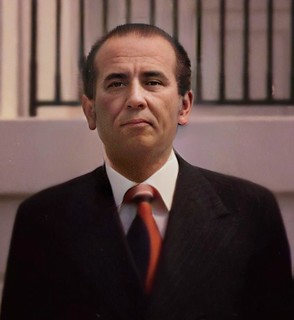 President Carlos Andrés Pérez nationalized Venezuela's oil industry on 1 January
1976.
President Carlos Andrés Pérez nationalized Venezuela's oil industry on 1 January
1976.
In this context, the moderate socialist Carlos Andrés Pérez came to power in 1974. He nationalized the entire oil sector and its huge revenues – and this is the occasion on which the coin offered by Künker was issued. In the following years, Venezuela became one of the wealthiest countries in South America. Between 1973 and 1983, the revenues made from the export of crude oil totaled astounding 240 billion dollars, the equivalent of 696 billion dollars today. The boom continued until the early 1980s. The state-owned oil company Petróleos de Venezuela, Petroven for short, even expanded abroad. They bought refineries in the USA and Europe and became the world's third-largest oil company.
But then the tide turned – not for the first time in Venezuela's history. After all, oil is a
double-edged sword that does not only bring wealth. Do you know the term Dutch disease
?
Economists use it to describe a complex phenomenon. It can be summarized as follows:
countries that make very high profits from exporting commodities experience slumps in other
economic sectors. Venezuela is considered a prime example of this phenomenon. When the
oil price started to collapse in 1983, the country couldn't compensate for the missing
revenues. The boom was followed by a severe, long-lasting economic crisis. That's why the
oil industry was reopened to foreign participation in the 1990s – and then Hugo Chávez came
to power in 1999. The socialist, who was considered rather problematic by many other
countries, got lucky – in 2007 the oil price rose again to unprecedented heights. Under the battle cry The oil belongs to all Venezuelans!
, President Chávez nationalized the country's
oil industry once again in 2007.
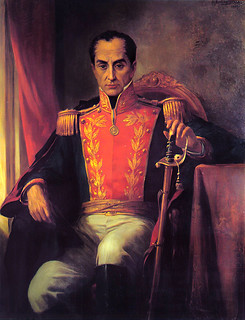 Simón Bolívar, called
Simón Bolívar, called El Libertador
(the Liberator), is considered the great freedom
fighter against Spanish colonialism in South America. Painting by Ricardo Acevedo Bernal.
El Libertador
Chávez referred to his reforms as a revolution. And he gave it a revealing title: The Bolivarian
Revolution. In this way, Chávez linked his measures to a man whom he considered his great
role model in the anti-imperialist
fight against foreign countries and who enjoyed great
popularity as a national hero in Venezuela: Simón Bolívar – the man we see on the reverse of
the 1975 gold coin.
Bolívar (1783-1830) is an icon of Latin America. In the early 19th century, he led the continent's war of independence against Spanish colonial forces, and he is considered a national hero of many South American countries that owe their independence to him. Bolívar is seen in that way in Bolivia, which was named after him, and in Venezuela, whose borders include his birthplace – much to the pride of the Venezuelan people.
The fact that Bolívar's death in 1830 was perceived more as a liberation and a relief by his contemporaries didn't interest anyone anymore just a few years later. To this day, he is admired, revered, and transfigured. All political camps like to refer to Bolívar. Accordingly, he often appears on the coins of Venezuela and other South American countries.
Another Venezuelan coin commemorating Bolívar from Künker's current auction sale: 10,000 Bolívares 1987. Proof. Estimate: 1,250 euros. From Künker auction 371 (22 to 24 June 2022), No. 2423.
Would Bolívar have approved of this nationalization of the oil industry? Well, since he died in 1830 – long before the combustion engine was invented – he obviously never said anything about this. From a socialist point of view, however, the nationalization can be perfectly interpreted as a decolonization and a liberation à la Bolívar given that the act prevents foreign countries from making money with Venezuelan oil. That might be the reason why his portrait is depicted on the 1975 coin. By the way, the Venezuelans also named their currency after him, and this name hasn't been changed since 1879: the Bolívar.
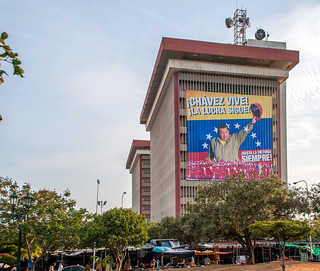 A building of the state oil company Petroven with a Chávez poster.
A building of the state oil company Petroven with a Chávez poster.
The nationalization of the oil industry in 1975 was an important moment in Venezuela's history and brought great prosperity to the country. The second nationalization in 2007 incidentally had a completely different outcome. Since urgently needed investments failed to materialize and massive mismanagement prevailed, the oil industry – and with it the whole of Venezuela – fell into a downward spiral. To this day, the country is struggling with an ongoing economic crisis and is no longer one of the continent's richest but one of the continent's poorest countries. Every few years, a few zeros are removed from the Bolívar to fight the never-ending inflation: in 2018 it was five zeroes, in 2021 six.
ROMAN SILVER COIN HOARD FOUND IN ROMANIA
A hoard of Roman silver coins has been found in Romania. Found via The Explorator newsletter. To subscribe to Explorator, send a blank email message to: explorator+subscribe@groups.io. -Editor
A treasure hunter from Mure? County has discovered a hoard of silver coins dating back to the time of the Romans. The more than 300 coins were found in a clay pot, buried in the earth of the forest of Sângeru de Padure, which the man had been scanning with a metal detector.
The 43-year-old treasure hunter, Narcis Car?i?, is an impassioned history lover and enjoys spending his free time searching for archaeological remains. In fact, the discovery he just made is not his first. About a year and a half ago, Mr. Car?i? obtained his detectorist's license, and since then he has made three archeological discoveries. The first time he discovered four tetradrachms, large silver coins originating in Ancient Greece which were the standard coin of the Antiquity. The second discovery was a pot full of coins dating from Antiquity which he found in the Ernei area of Mure? county. And now this hoard from the forest of Sângeru de Padure.
After inspecting the pot filled with coins, while making sure not to move it from its current position in the ground, Mr. Car?i? contacted the Mure? County Museum.
To read the complete article, see:
2000-year-old treasure found in a forest of Mure? county, central Romania
(https://www.romania-insider.com/silver-coin-treasure-found-central-romania)
MEXICAN CURRENCY EXCHANGE IN PUERTO RICO
Here's the English abstract of an article by Angel Navarro published in a peer-reviewed journal in Spain. The complete article is available in .pdf format. -Editor
The exchange of the mexican currency for the provincial peso in Puerto Rico (1895-1896) and Bartolomé Maura y Montaner
Abstract. In this research, we have reconstructed a part of the monetary history of Puerto Rico in the late nineteenth century. Our object of study has been the problem of the Mexican currency that circu-lated in Puerto Rico and the provincial peso minted in the Fábrica Nacional de Moneda y Timbre in Madrid, to face this problem on the island (1895-1896). The provincial peso of Puerto Rico and the Exchange Note (Paper Money) used to carry out the exchange of the Mexican currency for the pro-vincial peso were designed by the great artist and most prominent Spanish engraver of his time, Don Bartolomé Maura y Montaner. During the initial investigation, we could locate the original design of the Exchange Note (Paper Money), and the number of exchange notes manufactured to facilitate this monetary exchange is evident (5,000,000). We dare to affirm that the Exchange Note has been the paper money with the shortest time in circulation in some territories or country (it circulated freely for 21 days).
To read the complete article, see:
El canje de la moneda mexicana por el peso provincial en Puerto Rico (1895-1896) y Bartolomé Maura y Montaner
(https://revistas.ucm.es/index.php/DOCU/article/view/81329/4564456560503)
BORDER PATROL "WHIPPING' CHALLENGE COINS
Continuing with the theme of controversial challenge coins, earlier this week CNN published an article about a challenge coin with an image based on the controversial photo of a Border Patrol agent "whipping" a migrant near the Texas border. -Editor
An unofficial challenge coin depicting the infamous image of an agent on horseback confronting a Haitian migrant is being investigated by US Customs and Border Protection's Office of Professional Responsibility, according to agency spokesperson Luis Miranda.
The coin, which was on sale on eBay, is inscribed with phrases, like "You will be returned" and "Reining it in since May 28, 1924." It's unclear where the coin originated.
"The images depicted on this coin are offensive, insensitive, and run counter to the core values of CBP. This is not an official CBP coin," Miranda said in a statement.
Challenge coins are historically collectable pieces of recognition that originated in the military but have become more popular with civilian agencies. They are often used to trade and given as tokens of gratitude.
To read the complete article, see:
US Customs and Border Protection investigating an unofficial challenge coin depicting Haitian migrant incident
(https://www.cnn.com/2022/06/16/politics/unofficial-challenge-coin-haitian-migrant-incident-investigation-cbp/index.html)
National Public Radio published images of the piece. -Editor
A Utah man has found himself in the middle of a controversy this week over a set of challenge coins he sold on eBay featuring a shocking image.
The coins depict the now-infamous, real-life image of a Border Patrol agent chasing down Haitian migrants along the U.S.-Mexico border last September.
Unless he hears otherwise from authorities, the seller, Andy Christiansen, told NPR that he still has about 20 coins left and intends on putting them up for sale again.
"It's strictly a business for me," he told NPR over the phone. And it's apparently a popular one at that.
Once the eBay listing of this particular coin made its rounds, Christiansen said, it was "flying off the shelf" at one point. Interest was big enough to inflate the cost of one coin to nearly $500.
CBP had indicated this week that it was investigating the origin of the coins. So following those statements, Christiansen took the eBay posting down for the time being.
But as of Friday afternoon, he told NPR, he had yet to hear anything from any investigators. He's planning on reselling the 20 or so coins he has left unless he hears from CBP or other authorities. A challenge coin is a type of small medallion that bears an organization's or group's insignia, and it's usually carried by its members. Members of the military often have these coins.
Christiansen said he is not the manufacturer of these coins; the person or business that ordered or manufactured these coins is still a mystery.
He runs a business in Utah that buys at auction items that were lost or damaged during shipping by FedEx or the U.S. Postal Service. That's how he came into possession of the coins — mixed in a box with other challenge coins, Christiansen said. He said he was unaware of the meaning of what was depicted on the coins.
Subject matter notwithstanding, the quality of workmanship on these pieces is very good - those are nicely done images in high relief. -Editor
To read the complete article, see:
EBay seller says coins depicting Haitian migrant incident at border may be sold again
(https://www.npr.org/2022/06/17/1105901312/ebay-seller-challenge-coins-border-patrol-horseback-haiti-migrants-mexico)
The New York Post pictured a different example of much lower quality - there are more than one design out there. -Editor
To read the complete article, see:
Controversial ‘whipping' Border Patrol incident now on challenge coin
(https://nypost.com/2022/06/17/whipping-border-patrol-incident-shown-on-challenge-coin/)
To read the earlier E-Sylum articles, see:
MARYLAND CHALLENGE COIN PROMPTS PROTEST
(https://www.coinbooks.org/v25/esylum_v25n23a29.html)
LOOSE CHANGE: JUNE 12, 2022 : Creator of Offensive Maryland Challenge Coin Identified
(https://www.coinbooks.org/v25/esylum_v25n24a32.html)
ELIZABETH II ON NEW ZEALAND CURRENCY
Martin Purdy writes:
"Following up on the item in The E-Sylum on effigies of the Queen on currency around the world, our Reserve Bank here in NZ recently published this to mark the Platinum Jubilee. Both components in the paper were originally more detailed but a bit wound up on the cutting-room floor to make it fit the required format."
Nicely done - the complete paper is available online. -Editor
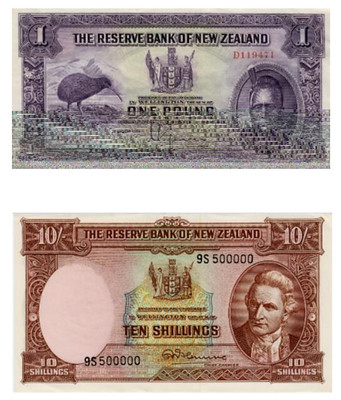 Although an image of the Queen has graced the ‘heads' side of
New Zealand's coins since 1953, she did not appear on our
banknotes until the introduction of decimal currency in 1967
when the Reserve Bank issued its third series of banknotes. Her
portrait has also appeared in each series following: Series 4, 1981;
Series 5, 1991; Series 6, 1999, and Series 7, 2015. A short timeframe to prepare and print the Series 1 notes (1934), apparently
prevented a portrait of King George V (reigned 1910 - 1936d)
being included, while King George VI (reigned 1936 - 1952d) was
not included in Series 2 (1940). The second Maori King, Tawhiao
(c1822 - 1894), featured on each Series 1 banknote, while Captain
James Cook (1728 - 1779) did likewise on Series 2. Both series
were printed by De La Rue.
Although an image of the Queen has graced the ‘heads' side of
New Zealand's coins since 1953, she did not appear on our
banknotes until the introduction of decimal currency in 1967
when the Reserve Bank issued its third series of banknotes. Her
portrait has also appeared in each series following: Series 4, 1981;
Series 5, 1991; Series 6, 1999, and Series 7, 2015. A short timeframe to prepare and print the Series 1 notes (1934), apparently
prevented a portrait of King George V (reigned 1910 - 1936d)
being included, while King George VI (reigned 1936 - 1952d) was
not included in Series 2 (1940). The second Maori King, Tawhiao
(c1822 - 1894), featured on each Series 1 banknote, while Captain
James Cook (1728 - 1779) did likewise on Series 2. Both series
were printed by De La Rue.
New Zealand was one of the last countries to switch to decimal currency. Dollars and cents replaced pounds, shillings and pence on 10 July 1967. Public interest in the introduction of decimal currency was high, and everyone had an opinion on the designs of the new coins and banknotes. The final note designs were tightly guarded by the Reserve Bank and released in June 1967, only a month before ‘DC Day', short for Decimal Changeover Day. The Reserve Bank was keen to avoid giving any advantage to would-be counterfeiters wanting to con a public unfamiliar with the new genuine banknotes.
All six new banknote denominations were of different sizes and colours but had a very similar face design which was dominated by a stately portrait of Queen Elizabeth II, unsmiling but dignified, facing slightly to the viewer's left and wearing a tiara. Maori motifs and geometric patterns were added to enhance the design and supply the necessary security. This portrait of the Queen was one of the more widely-used throughout the British Commonwealth; being selected by five other countries to feature on their banknotes. The engraving was based on a photograph taken by London photographer Anthony Buckley several years earlier (on 19 October 1960) in the Blue Drawing Room of Buckingham Palace when the Queen was 34 years old. Some publications incorrectly state the photograph was taken at the time of the Queen's Coronation in 1953.
To read the complete article, see:
The Queen on New Zealand's currency
(https://www.rbnz.govt.nz/hub/publications/bulletin/2022/rbb2022-85-01)
To read the earlier E-Sylum articles, see:
ELIZABETH II'S IMAGE ON BANKNOTES
(https://www.coinbooks.org/v25/esylum_v25n24a29.html)
MORE QUEEN ELIZABETH II BANKNOTE PORTRAITS
(https://www.coinbooks.org/v25/esylum_v25n24a30.html)
A SINGLE LATIN AMERICAN CURRENCY?
Howard Berlin passed along this article about ideas for Latin American currency union. -Editor
For Luiz Inacio Lula da Silva, a candidate in the forthcoming Brazilian presidential election, it's a question of independence for the entire region. "If God wills, we will create a common currency for Latin America, because we shouldn't be dependent on the dollar," he said a few weeks ago.
It remains to be seen whether this was just an attempt to create an issue in the early stages of the election campaign or whether the former Brazilian president (2003-2011), who is currently leading the polls, is serious about this idea. Either way, it has sparked a debate. The Argentine business portal El Destape subsequently asked: "A single currency for all of Latin America — is that possible?"
A currency called "south"
The idea is not new. An original proponent is the Brazilian Fernando Haddad, former mayor of Sao Paulo and ex-presidential candidate of the left-wing Workers' Party (PT), who lost the 2018 ballot to current incumbent Jair Bolsonaro. He recently brought up the idea again in a guest article for the newspaper Folha. He even suggested a name — sur, meaning south. The fact that Lula, as a political heavyweight in Latin America, took up the topic shows that it has what it takes to move people both emotionally and politically.
No easy way forward
The idea of ??a single currency is easy to formulate, but the path to creating it is complicated. Jacques D'Adesky from the Fluminense Federal University in Rio de Janeiro referred to the existing differences and historical rivalries, for example between neighboring Argentina and Brazil. "The formation of a single currency zone would initially require many negotiations between the future partners," he told DW, saying such a process would take years.
Economist Leandro Dias from AkinTec bank in Sao Paulo wants to wait and see whether the idea survives the current election campaign. In principle, the Mercosur economic area has already contributed to the region working more closely together. However, "most countries would like to retain their sovereignty and economic independence," Dias told DW.
To read the complete article, see:
The dream of a single Latin American currency
(https://www.dw.com/en/the-dream-of-a-single-latin-american-currency/a-62043189)
HIDDEN TREASURES OF THE ROYAL MINT MUSEUM
Chip Howell passed along this YouTube video on "Hidden Treasures Of The Royal Mint Museum." -Editor
To watch the complete video, see:
Revealing The Hidden Treasures Of The Royal Mint Museum
(https://www.youtube.com/watch?v=Jx3o_2yl-xI)
YALE'S GOLD IN AMERICA EXHIBIT
The Wall Street Journal article reviews a Yale University Art Gallery exhibit in gold in America. Here's an excerpt. -Editor
At the Yale University Art Gallery, the current show Gold in America: Artistry, Memory, Power
examines with insight and wit the prominent role played by this noble metal in the course of over 400 years.
The Yale University Art Gallery houses the finest collection of early American gold of any museum,
the show's organizer, John Stuart Gordon, the gallery's curator of American decorative arts, s ays in the exhibition's press release. Drawing upon this collection, with additional objects lent by the Yale Center for British Art, the Yale Peabody Museum of Natural History and private collections, Mr. Gordon has assembled over 70 examples of American gold that represent how the precious metal was used by those sufficiently wealthy and powerful to afford it.
This is not a glittery exhibition, but one that glows serenely. Many of the beautiful objects presented here, including gold tableware, medals, betrothal and mourning rings, fraternal badges, and other jewelry, embody the exceptional craftsmanship and artistry that the metal inspired as well as the techniques of traditional goldsmithing that went into their creation.
Of more public historical significance is the gold freedom box awarded to Revolutionary War hero Baron Friedrich Wilhelm von Steuben, the Prussian officer who helped whip George Washington's ragtag Continental Army into a disciplined military force. Freedom boxes were the equivalent of a key to the city, and this one, wrought by American goldsmith Samuel Johnson and beautifully engraved by Peter Rushton Maverick, was commissioned by the City of New York in 1784 in gratitude for Steuben's efforts. From a technical standpoint, the box represents the earliest known employment of bright-cut decoration in American goldsmithing. Bright cutting, which became definitive of Federal-style metalwork, is a technique of incising short, angled strokes with a polished engraving tool into gold, silver or copper, then burnishing the resulting planes to achieve a sparkling effect.
Not all that shines here is made of gold. Among the curiosities is not an actual gold piece but a proof of a circa 1889 $100 gold certificate, a prototype bank note. Issued for public circulation from 1863 to 1933, gold certificates declared that the bearer could redeem them at a bank for the face value in actual gold coin. This design is ironic, because it features a portrait of Missouri Sen. Thomas Hart Benton, known in his day as Old Bullion
for his belief in hard money—actual gold currency—and dead set against paper money merely backed by gold.
It is shown together with two of the most beautiful of all American gold coins. Both were commissioned by President Theodore Roosevelt, who wanted the U.S. Mint to raise the artistic standard of American coinage to that of ancient Greece. The celebrated $20 double eagle, with its obverse figure of striding Liberty, was issued from 1907 to 1933. Originally designed in high relief by sculptor Augustus Saint-Gaudens, it was modified in lower relief for practicable coinage production by the U.S. Mint's chief engraver Charles E. Barber. The $5 half eagle, designed by Saint-Gaudens's pupil Bela Lyon Pratt, was minted (with interruptions) from 1908 to 1929. Instead of modeling the obverse profile of a Native American in relief according to convention, Pratt designed it like an intaglio, with the head (and the eagle on the reverse) incused. Like Saint-Gaudens's coin, Pratt's also had to be modified by Barber.
To read the complete article (subscription required), see:
‘Gold in America: Artistry, Memory, Power' Review: A Glittering Standard of Beauty
THE SAIFABAD MINT MUSEUM
This article describes a new Mint Museum in Hyderabad, India. -Editor
Did you know that the world's largest gold coin weighing 11 kg was minted in India and came to be with the Nizams of Hyderabad?
For those who are interested in knowing such facts or technology pertaining to the evolution of coins and currency, here is a chance to visit the new Saifabad Mint Museum in Hyderabad which opened to the public on Wednesday.
It offers an exciting journey through the world of coins and currency to the visitors with historical facts and the antique equipment used in the mining world about a century ago. The coins and currency used in the country since independence which are now obsolete are also on display.
Visitors who thronged the museum on day one of the opening said it was a spectacle of the history of coins
.
The Saifabad Mint Museum has been set up by the Security Printing and Minting Corporation of India Ltd (SPMCIL) as part of ‘Azadi Ka Amrit Mohostav' in a mint facility which was abandoned in 1990s.
The museum recalls the history of coinage and currency of Nizam Mir Akbar Ali Khan Sikander Jha who commenced minting his coins in 1803.
The exhibits in the museum include coins and currency issued by the Hyderabad state and the equipment that was used in the process including huge manual balance, weights and measures.
Other special attractions include the replicas of the world's largest 1,000 tolas Mughal gold coin Muhr issued by Emperor Jahangir in the 17th Century and the famed silver Rupee issued by the ruler of Delhi Sher Shah Suri in the 16th century.
To read the complete article, see:
A new Mint Museum showcases history, technology of coins and currency
(https://www.thehindubusinessline.com/news/variety/a-new-mint-museum-showcases-history-technology-of-coins-and-currency/article65506980.ece)
LOOSE CHANGE: JUNE 19, 2022
Here are some additional items in the media this week that may be of interest. -Editor
This article on the Künker website tells how the Portugaleser gold coins came to be. -Editor
This story starts with a plain fact: in the late Middle Ages, there was hardly any gold left in Europe because there were simply no rich deposits on the continent. Portugal took advantage of the great demand for this precious metal since the seafaring nation had excellent trade connections to Africa, which was rich in gold. Around 1500, Lisbon became a key place of gold transshipment. Starting in 1499, the Portuguese minted large gold trading coins worth 10 cruzados, which pretty much equaled 10 ducats. These coins were called Portuguez and were soon accepted in various parts of the world. This also applied to northern Europe, where the coins were readily accepted in the wealthy merchant towns of northern Germany and the Netherlands. And it did not take long for the first imitation coins to be produced. In the Holy Roman Empire, these coins were called portugalesers, which simply means Portuguese
.
Portugalesers established themselves and continued to bear this name even when the gold had long ceased to come from Portugal. At no point, however, was this coin type particularly common. After all, the value of such a coin equaled what a journeyman bricklayer from Hamburg earned in 108 days of work. Right from the outset, the coin had mainly been used for the long-distance trade or as a valuable gift.
Princes in northern Europe who thought highly of themselves and wanted to distribute representative gifts also minted portugalesers from time to time – including the house of Hohenzollern in Brandenburg. But only a few issues were minted there: only three different full-weight Brandenburg portugalesers of 10 ducats from the 16th century are known of.
To read the complete article, see:
Portugalesers: A Close Look at Brandenburg's Gold Showpieces
(https://www.kuenker.de/en/information/presseinformationen/aktuelle-mitteilungen/437)
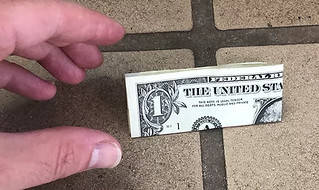
A bad day can become a really good one if you wind up finding some money on the ground, but it turns out that for some folks, finding a $1 bill on the floor could turn a good day into the worst one ever. In fact, according to one Tennessee police department, picking up a folded dollar bill could be deadly.
The warning came in the form of a public safety notice posted on the Giles County Sheriff Department's Facebook page. In it, they explain that there have been two recent incidents in the area where a folded dollar bill was discovered on the floor of a gas station and both bills had a white powdery substance inside. The powder was sent in for testing where it was identified as methamphetamine and fentanyl.
To read the complete article, see:
If You See A Folded $1 Bill On The Ground, Police Warn Do Not Pick It Up
(https://elvisduran.iheart.com/content/2022-06-13-if-you-see-a-folded-1-bill-on-the-ground-police-warn-not-to-pick-it-up/)
While non-numismatic, this nonfiction book about a fictional series does reference "an eccentric stamp collector". Many of our readers I'm sure are old enough to have grown up with The Hardy Boys and other young adult fiction of the time. Ghost of the Hardy Boys is a behind-the-scenes look by one of the famous series' hired ghostwriters, and this excerpt is a real hoot (the one here, not so much, but click thru to learn about the Hardy Boys, their girlfriends, and "the borders of wholesome friendship and discreet mutual esteem." -Editor
The Hardy Boys!
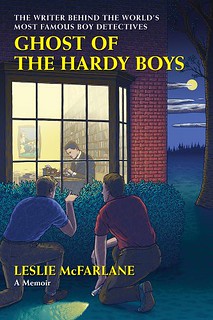 This would be the title of the series. My pseudonym would be Franklin W. Dixon. (I never did learn what the
This would be the title of the series. My pseudonym would be Franklin W. Dixon. (I never did learn what the W
represented. Certainly not Wealthy.)
Stratemeyer noted that the books would be clothbound and therefore priced a little higher than paperbacks. This in turn would justify a little higher payment for the manuscript—$125 to be exact. He had attached an information sheet for guidance and the plot outline of the initial volume, which would be called The Tower Treasure. In closing, he promised that if the manuscript came up to expectations—which were high—I would be asked to do the next two volumes of the series.
I skimmed through the outline. It was about a robbery in a towered mansion belonging to Hurd Applegate, an eccentric stamp collector. The Hardy Boys solved it.
To read the complete article, see:
THE BIRTH OF THE HARDY BOYS
(https://crimereads.com/the-birth-of-the-hardy-boys/)

